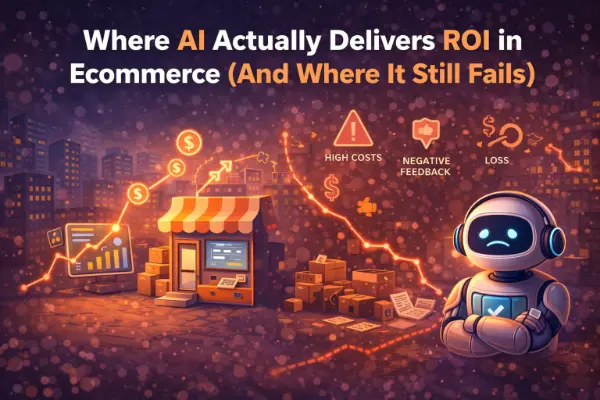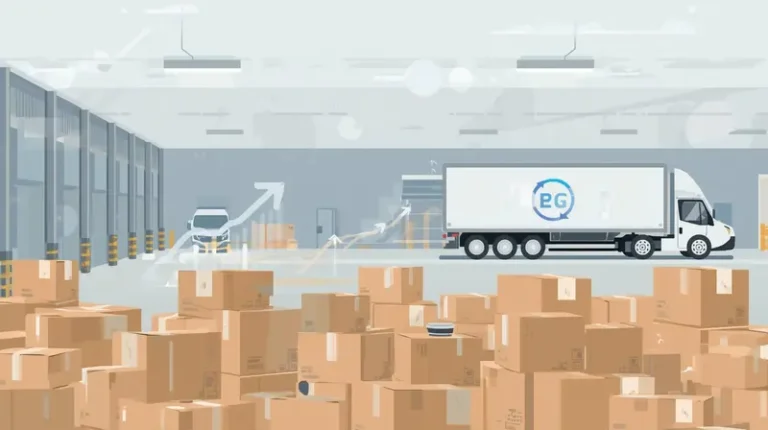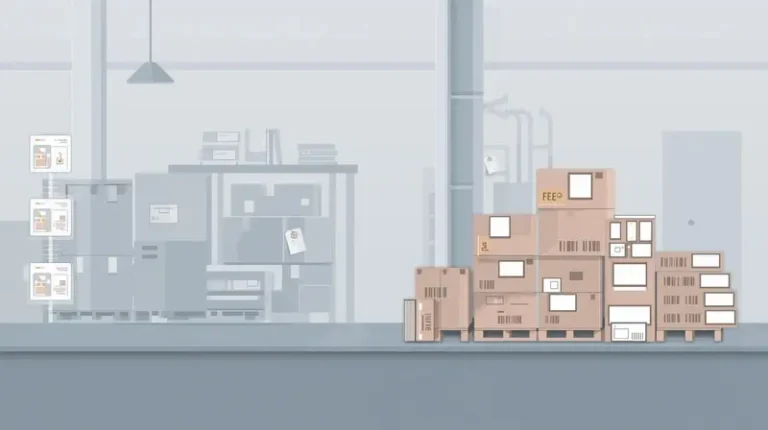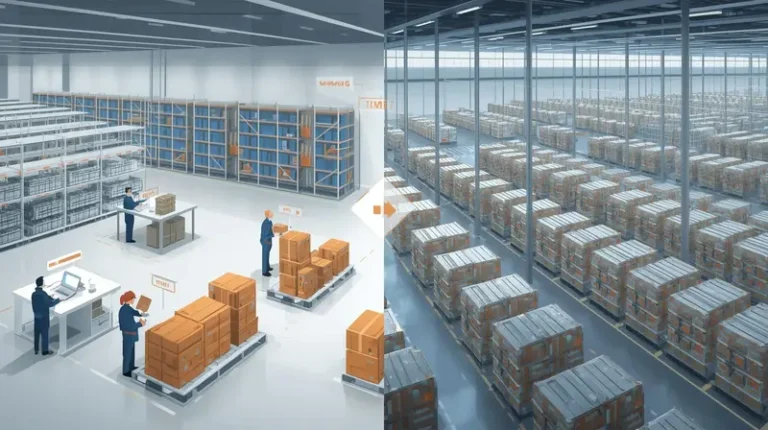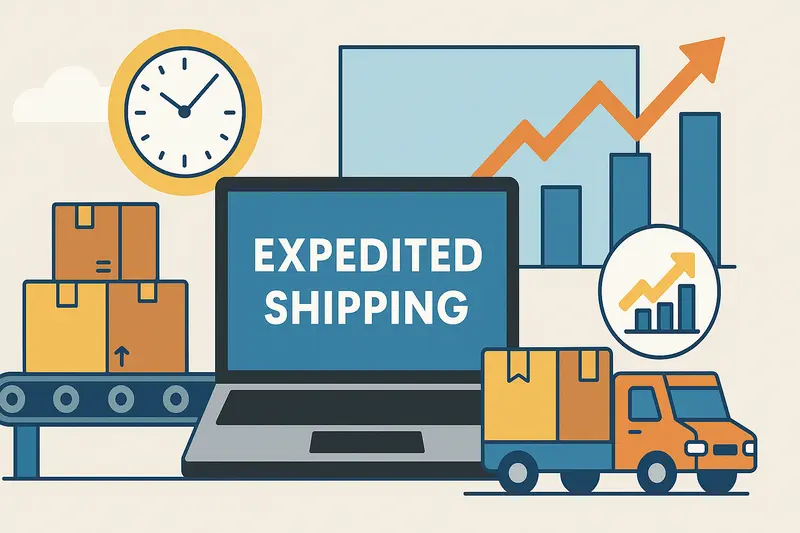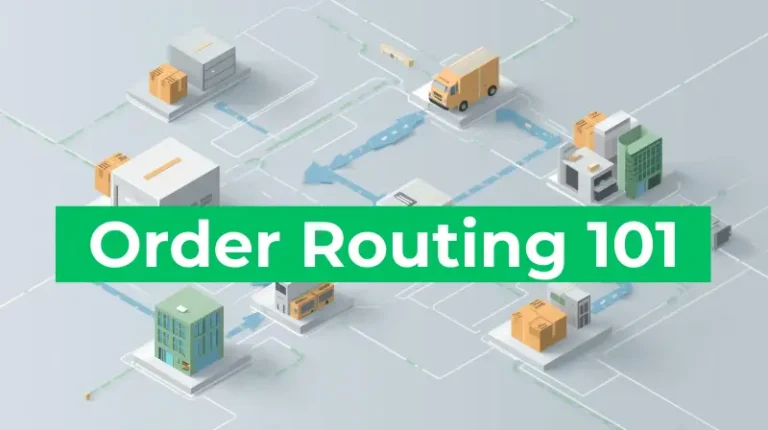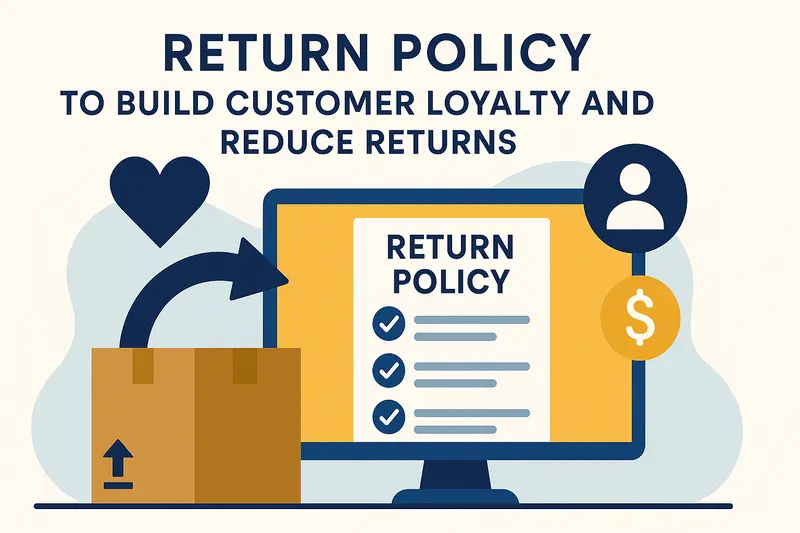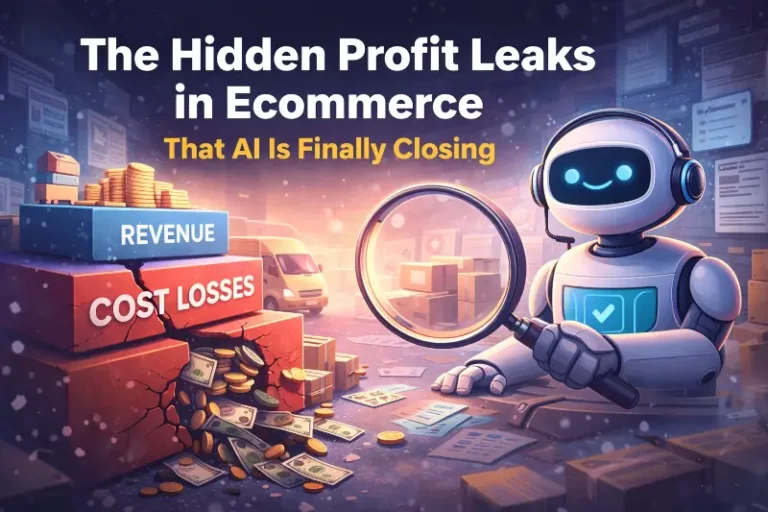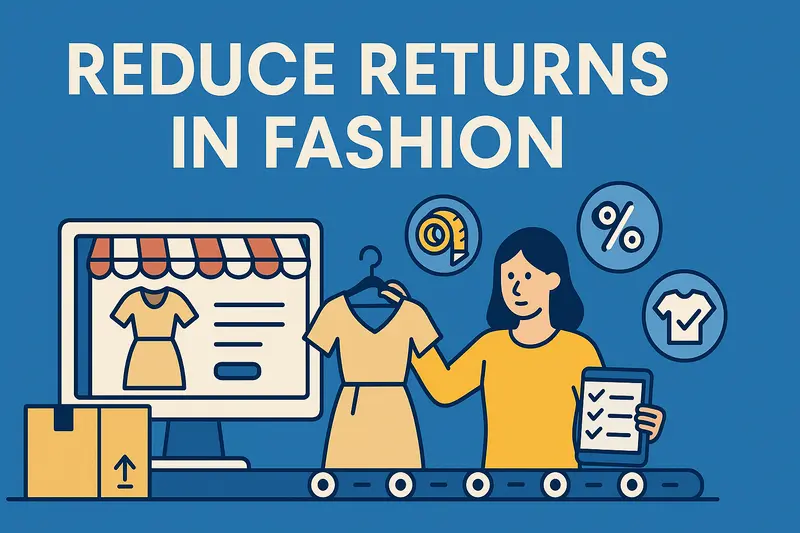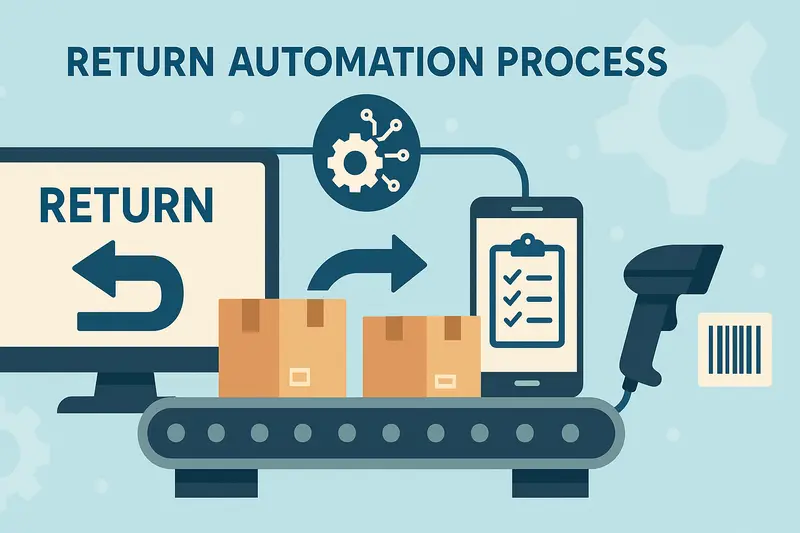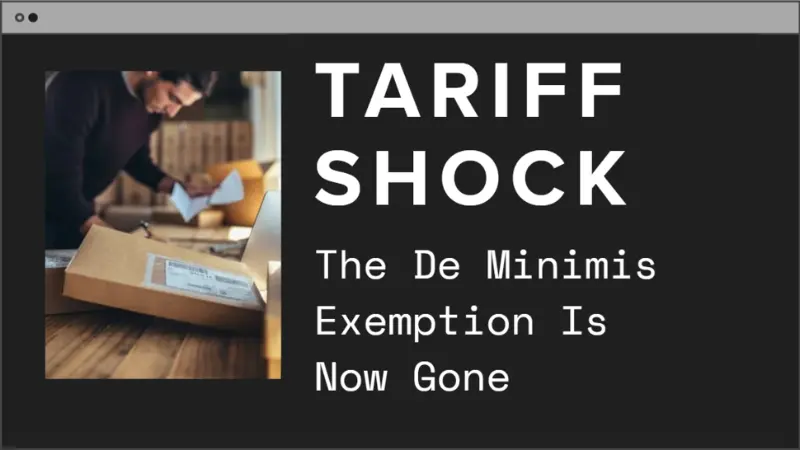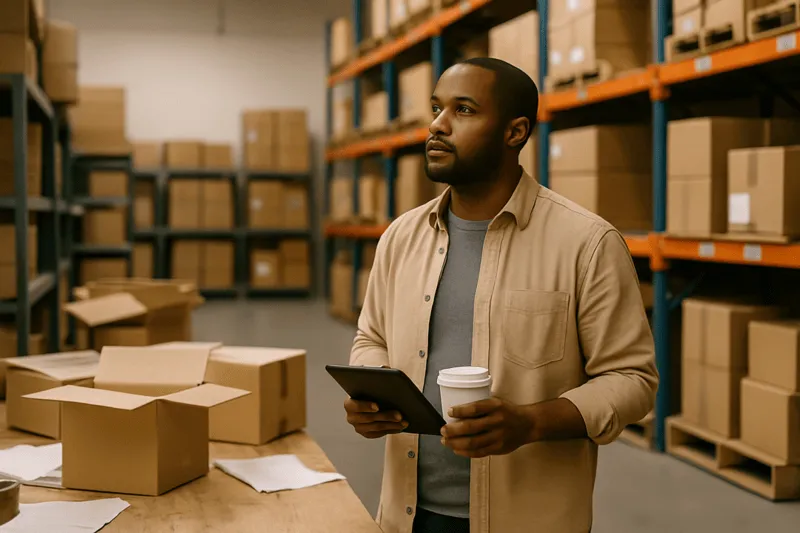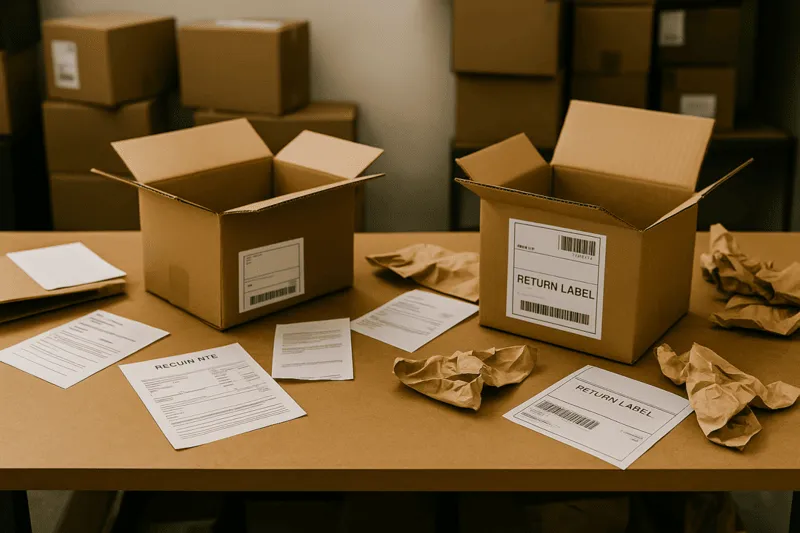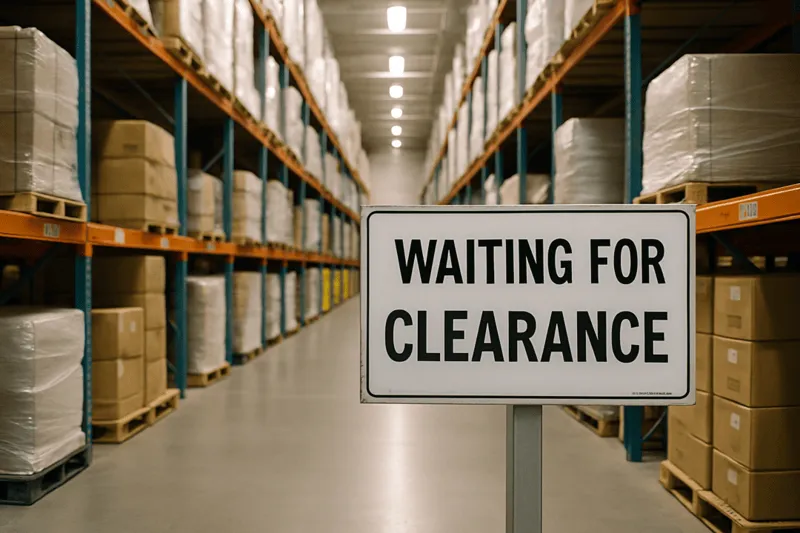Where AI Actually Delivers ROI in Ecommerce (And Where It Still Fails)
In this article
 5 mins
5 mins
- Why “AI ROI” Is the Wrong Question for Ecommerce
- Where AI Is Delivering Real ROI Today
- The High-ROI AI Use Case Most Brands Ignore: Fee Recovery
- Where AI Still Breaks And Costs Brands Money
- Why AI Struggles More With Strategic Decisions
- How Ecommerce Operators Should Evaluate AI ROI Going Forward
- AI ROI Is About Precision, Not Promise
- Frequently Asked Questions
AI is everywhere in ecommerce conversations but ROI is not.
For every success story about automation and efficiency, there’s another quietly shelved AI project that failed to deliver meaningful results. The gap isn’t caused by bad technology. It’s caused by misplaced expectations.
The question ecommerce operators should be asking isn’t whether AI works. It’s where AI delivers real ROI today and where it still breaks down.
The difference matters. Especially now, when margin pressure, shipping costs, and operational complexity leave little room for experimentation without payoff.
Many of the examples in this article are drawn from real conversations with ecommerce operators, including insights shared during an Ugly Talk live panel co-hosted by Cahoot in New York. The discussion focused on where AI is delivering measurable ROI in ecommerce today—and where it’s quietly creating new problems. What emerged wasn’t hype, but a clear pattern: AI works best when it’s constrained to execution, not judgment.
Why “AI ROI” Is the Wrong Question for Ecommerce
AI does not produce universal ROI across all functions. It produces situational ROI.
When brands ask whether AI is “worth it,” they lump together radically different use cases: advertising optimization, pricing strategy, customer service, forecasting, logistics, and finance. These domains have different data structures, feedback loops, and risk profiles.
As a result, many AI initiatives fail not because the technology is flawed, but because it’s applied to problems that are not yet solvable (or not solvable) without human judgment.
Understanding AI ROI starts with understanding task suitability, not ambition.
Where AI Is Delivering Real ROI Today
Across ecommerce operations, AI consistently delivers strong returns in environments that share three traits:
- High data volume
- Repeatable decisions
- Clear feedback loops
Several use cases stand out.
Slash Your Fulfillment Costs by Up to 30%
Cut shipping expenses by 30% and boost profit with Cahoot's AI-optimized fulfillment services and modern tech —no overheads and no humans required!
I'm Interested in Saving Time and MoneyAdvertising Optimization at Scale
AI excels at identifying patterns humans cannot see across thousands of campaigns, creatives, and keywords. In paid media, this translates into faster iteration, more efficient spend allocation, and measurable performance lift.
This is one of the earliest areas where ecommerce brands see ROI, not because AI is “creative,” but because optimization at scale is fundamentally computational.
During the panel, one operator shared how AI surfaced unexpectedly high-performing niches that human teams had historically overlooked. A standout example was “pencil Christmas trees” which is a narrow, space-saving variant that didn’t register as a priority category for planners. AI detected strong conversion signals and unmet demand across marketplaces, enabling the brand to lean in early. The result wasn’t a creative breakthrough. It was executional awareness at scale, something humans are structurally bad at spotting.
Humans optimize around what they already know; AI optimizes around what the data reveals even when the opportunity looks small or uninteresting.
Demand Signals and Forecasting
While perfect forecasting remains elusive, AI-driven demand signals are already improving inventory planning and promotional timing. Even modest accuracy improvements can unlock meaningful cost savings by reducing stockouts and overstock scenarios.
Workflow Automation
AI delivers ROI by removing humans from low-value coordination tasks: data reconciliation, routing decisions, and exception triage. These gains don’t always show up as revenue growth, but they show up clearly in time saved and error reduction.
These wins form the backbone of AI ROI in ecommerce operations, especially when integrated across systems instead of deployed as isolated tools.
The High-ROI AI Use Case Most Brands Ignore: Fee Recovery
One of the most overlooked (and consistently profitable) AI applications in ecommerce is fee recovery.
Platforms and carriers process millions of transactions at scale. Errors are inevitable. What’s remarkable is not that errors exist, but that most brands never notice them.
AI is uniquely well-suited to this problem.
By continuously auditing transactions, reconciling invoices, and flagging anomalies, AI can recover revenue that would otherwise disappear unnoticed. This includes:
- Marketplace fee discrepancies
- Shipping overcharges
- Missed refunds
- Billing mismatches
These recoveries often feel “boring” compared to growth initiatives. But they deliver direct, bottom-line impact, especially in tight margin environments.
This is a prime example of AI delivering ROI quietly, without requiring behavioral change or customer-facing risk.
Looking for a New 3PL? Start with this Free RFP Template
Cut weeks off your selection process. Avoid pitfalls. Get the only 3PL RFP checklist built for ecommerce brands, absolutely free.
Get My Free 3PL RFPWhere AI Still Breaks And Costs Brands Money
For all its strengths, AI still struggles in several high-profile ecommerce applications.
Pricing Elasticity
Dynamic pricing remains one of the most overpromised AI use cases. While AI can react to competitor pricing or inventory levels, it still struggles to model true consumer elasticity. Particularly across brands, channels, and emotional buying contexts.
Incorrect price moves can damage brand perception or erode margins faster than they improve them.
Unverified Recommendations
One panelist shared a costly example of AI-driven content optimization gone wrong. AI identified “UV resistant” as a high-conversion keyword for artificial plants and began inserting it into product listings without anyone verifying whether the products were actually UV resistant. Conversions initially improved, but the downstream impact was severe: higher return rates, customer complaints, and expensive chargebacks once buyers realized the plants degraded outdoors. The AI did exactly what it was trained to do (optimize for conversion) but without human verification, it optimized straight into margin loss.
Over-Automation Without Escalation
AI systems that operate without human review in ambiguous scenarios often fail in subtle but costly ways. Customer frustration, misrouted returns, and incorrect resolutions accumulate quietly until they surface as reputation damage.
These failures don’t mean AI is ineffective. They mean the wrong tasks were automated too aggressively.
Why AI Struggles More With Strategic Decisions
AI performs best when outcomes are measurable and feedback is fast.
Strategic decisions like pricing architecture, brand positioning, customer trust; involve causality, emotion, and long-term tradeoffs. These are areas where human judgment still outperforms algorithms.
When AI is pushed into these domains without guardrails, ROI becomes unpredictable. Successful operators treat AI as a decision engine for execution, not vision.
This distinction separates disciplined AI adoption from expensive experimentation.
How Ecommerce Operators Should Evaluate AI ROI Going Forward
Evaluating AI ROI requires a shift in framing.
Instead of asking:
- “Will this AI tool grow revenue?”
Ask:
- Does this task repeat frequently?
- Is performance measurable?
- Is feedback timely?
- Is failure recoverable?
High-ROI AI initiatives tend to:
- Reduce cost leakage
- Improve consistency
- Compress learning cycles
- Eliminate manual coordination
Low-ROI initiatives often aim to replace judgment instead of supporting it.
Brands that apply this filter consistently avoid most AI disappointment and compound value faster.
Scale Faster with the World’s First Peer-to-Peer Fulfillment Network
Tap into a nationwide network of high-performance partner warehouses — expand capacity, cut shipping costs, and reach customers 1–2 days faster.
Explore Fulfillment NetworkAI ROI Is About Precision, Not Promise
AI is not a magic lever for ecommerce growth. It is a precision tool.
When applied to the right problems, AI delivers undeniable ROI: quietly improving margins, reducing waste, and accelerating execution. When misapplied, it creates false confidence and hidden risk.
The next phase of ecommerce will reward operators who deploy AI with discipline rather than ambition.
Not everywhere.
Not all at once.
But exactly where it works.
Frequently Asked Questions
What ecommerce use cases deliver the highest AI ROI today?
AI delivers the strongest ROI in repeatable, data-rich areas such as advertising optimization, fee recovery, forecasting, and operational automation.
Why does AI struggle with pricing optimization?
Pricing requires elasticity modeling, brand context, and consumer psychology. Basically areas where AI still lacks reliable causal understanding.
Is AI ROI easier to achieve for small ecommerce brands?
Often yes. Smaller teams can implement AI faster, test narrowly, and iterate without organizational friction.
How should ecommerce brands measure AI ROI?
Measure AI ROI by task-level outcomes: time saved, errors reduced, costs recovered, and learning speed. We should not abstract efficiency claims.

Turn Returns Into New Revenue
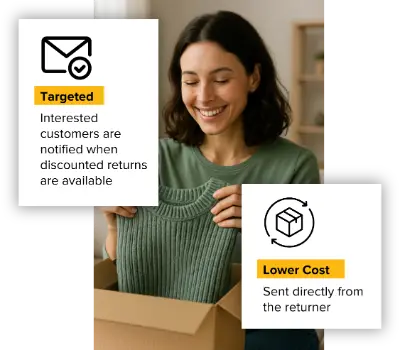
Expedited Shipping in 2025: What Businesses Need to Know
In this article
 4 minutes
4 minutes
- What Types of Expedited Shipping Services Are Available?
- How Macroeconomic Trends Are Shaping Expedited Shipping
- Which Expedited Options Work Best for U.S. and International Shipping?
- How Technology is Advancing Expedited Shipping
- Managing the Costs of Expedited Shipping
- The Future of Expedited Shipping
- Final Takeaway: Winning the War, Not the Battle
Expedited shipping has evolved far beyond simply paying a premium to move packages faster. In today’s economy, speed is just one dimension—intelligence, technology, and network design are now the real drivers of success. With tariffs, geopolitical tensions, and shifting consumer expectations reshaping global commerce, businesses must rethink how they approach expedited shipping to protect margins and maintain customer satisfaction.
What Types of Expedited Shipping Services Are Available?
Traditionally, “expedited” meant air freight—paying more for faster delivery. That definition is outdated. Today, expedited shipping options include:
- Ground-based expedited delivery through regional carriers, which can often deliver two days faster than national carriers while covering 70% of the U.S. population.
- Air shipping, still used for urgent or long-distance shipments, though costly and carbon-intensive (six times more emissions than ground).
- Multi-warehouse distribution, where inventory is strategically placed closer to customers to shorten transit times.
- Cross-border expedited solutions, often using Delivered Duty Paid (DDP) services and digital customs documentation to prevent delays in clearance.
In short, expedited shipping is no longer just a service level—it’s a strategic supply chain design.
Slash Your Fulfillment Costs by Up to 30%
Cut shipping expenses by 30% and boost profit with Cahoot's AI-optimized fulfillment services and modern tech —no overheads and no humans required!
I'm Interested in Saving Time and MoneyHow Macroeconomic Trends Are Shaping Expedited Shipping
The ripple effects of tariffs, regulatory changes, and geopolitical tensions are reshaping shipping strategies.
- Tariffs are forcing brands to nearshore or onshore inventory instead of relying on just-in-time shipments from Asia. Models like shipping directly from China under the de minimis exemption have been dismantled, making them economically unfeasible.
- Geopolitical risks and congestion at ports create unpredictable delays, making distributed fulfillment and buffer stock more important than ever.
- Customs clearance has become a major bottleneck; shipments that once “sailed through” are now slowed by greater scrutiny, paperwork, and misclassification risks.
Expedited today doesn’t mean paying extra to skip the line; it means building resilient networks that anticipate bottlenecks before they happen.
Which Expedited Options Work Best for U.S. and International Shipping?
The right expedited strategy depends on destination:
- Domestic U.S. Shipping:
Success comes from a three-part formula—multi-warehouse distribution, regional + national carrier mix, and AI-driven routing. Orders must be dynamically assigned based on location, time, and carrier reliability, not just cost. - International Shipping:
Delivered Duty Paid (DDP) is critical. Without it, shipments may reach the destination country in days but sit in customs for weeks until duties are paid. Accurate digital paperwork and proper classification speed clearance. Partnerships also matter—global carriers like DHL offer smoother handoffs to local networks, while USPS depends on third-party agreements that may vary in efficiency.
Looking for a New 3PL? Start with this Free RFP Template
Cut weeks off your selection process. Avoid pitfalls. Get the only 3PL RFP checklist built for ecommerce brands, absolutely free.
Get My Free 3PL RFPHow Technology is Advancing Expedited Shipping
Technology has redefined expedited shipping in several ways:
- AI-driven routing and predictive labeling: Software can override carrier-promised dates by using real-world performance data to choose the fastest, most reliable carrier.
- Dynamic inventory placement: Algorithms analyze demand patterns, seasonality, and geography to place inventory closer to customers before orders arrive.
- Digital customs: Eliminating paper documents accelerates cross-border processing.
- Peer-to-peer fulfillment networks: Platforms like Cahoot leverage unused warehouse space across brands to create Amazon-like speed without massive capital investment.
Managing the Costs of Expedited Shipping
Expedited shipping will always be more expensive, but businesses can manage costs by:
- Strategically distributing inventory closer to customers to minimize long-zone shipping.
- Using AI to route orders based on actual carrier performance, avoiding missed delivery promises.
- Negotiating carrier contracts with both regional and national carriers for flexibility.
- Reducing air reliance, instead using smart ground optimization to cut costs and emissions.
- Consolidating cross-border shipments through hubs for better customs efficiency.
The cheapest way to go fast is often to already be there.
ShipStation vs. Cahoot: 21x Faster, Real Results
Get the inside scoop on how a leading merchant switched from ShipStation to Cahoot—and what happened next. See it to believe it!
See the 21x DifferenceThe Future of Expedited Shipping
Currently, expedited shipping represents about 10% of parcel volume but more than 20% of parcel spend. Looking ahead, several trends will shape the market:
- Regional fulfillment growth: Expedited will rely less on air and more on distributed ground networks.
- Sustainability pressure: Companies will shift away from carbon-intensive options toward smarter ground-based networks.
- Peer-to-peer fulfillment models: Shared warehouse capacity will allow smaller brands to achieve Amazon-level speed without massive infrastructure.
- AI and automation: Routing, labeling, and predictive delivery windows will increasingly be powered by AI instead of static carrier estimates.
In the near future, speed won’t be a premium—it will be the baseline.
Final Takeaway: Winning the War, Not the Battle
Many businesses still optimize for single cost levers—like choosing the cheapest port or focusing only on container costs. This often leads to higher expenses elsewhere, such as long cross-country parcel deliveries. Expedited shipping in 2025 requires a total cost of logistics mindset, where success is measured not just by speed but by efficiency, customer satisfaction, and sustainability.

Turn Returns Into New Revenue

Crafting a Return Policy that Drives Customer Loyalty and Reduces Returns
In this article
 7 minutes
7 minutes
- How to Create a Returns Policy That Benefits Both Your Customers and Your Business
- Balancing Generosity and Profitability in Your Returns Policy
- Monitoring and Improving Your Returns Policy Based on Customer Feedback
- Final Thoughts: Why Your Returns Policy Should Be a Key Component of Your Loyalty Strategy
Let’s talk about ecommerce returns policies. You might be thinking, “What’s the big deal? It’s just a formality, right?” Well, no; your returns policy can either make or break your relationship with your customers. If done right, it builds trust through transparency. If done wrong, it can prevent new customers from buying from you, or worse, it can send your loyal customers running for the hills.
A clear, customer-friendly returns policy isn’t just some legal jargon to throw on your website for show. It’s a vital piece of your customer growth and retention strategy. When your customers feel confident in your return process, they’re much more likely to hit the “buy” button. Why? Because they know that if something goes wrong, they’re covered. No one likes the feeling of getting stuck with a purchase they regret, so a transparent returns policy builds trust. And trust is the foundation of your relationship with your customer.
How to Create a Returns Policy That Benefits Both Your Customers and Your Business
Let’s dive into the how: how do you create a returns policy that strikes a perfect balance between establishing confidence and trust in your brand, and giving away the farm? First, keep it simple. Your returns policy should be straightforward enough that anyone can understand it in a few seconds. Don’t hide the details. Don’t make it overly complex with all kinds of ifs, thens, and buts. Customers don’t want to dig through pages of fine print to figure out how to return something. No one has time for that, especially when they’re annoyed about needing to send an item back.
Make Returns Profitable, Yes!
Cut shipping and processing costs by 70% with our patented peer-to-peer returns solution. 4x faster than traditional returns.
See How It WorksNext, let’s talk about timing. You need to give your customers enough time to make up their minds. A reasonable return window (30 days? 45 days?) is fair, but don’t go overboard. A year to return a pair of socks might sound generous, but it’s a logistical nightmare. Somewhere between “24 hours” and “whenever you feel like it” is the sweet spot. Make sure your policy includes crystal clear instructions: what’s returnable, how to return it, and whether it’s free or not (with the respective details).
Here’s an example: I bought a pair of shoes online. They were great in theory: super stylish. But, when I tried them on, they made me look like I was auditioning for a ’90s boy band. Not the vibe I was going for. Thankfully, the return policy was clear and painless. It wasn’t complicated, it didn’t require a dozen emails back and forth, and I got my refund promptly. That’s the type of experience you want to offer: easy, fast, and no run-around. A simple, straightforward policy will make your customers feel like you’ll take care of them if it comes down to it, and that’s important for growing organic brand affinity.
Balancing Generosity and Profitability in Your Returns Policy
Now, here’s the tricky part: balancing generosity and profitability. You want to be kind and flexible, but you also need to make sure your returns policy keeps the financials manageable. Offering free returns on every single order sounds nice, but in reality, not all businesses can afford it, and not all products warrant it.
Here’s the trick: limit what’s eligible for free returns. For example, offer free returns only on high-ticket items or for orders above a certain value. For smaller items, you could charge a small return fee or ask customers to cover return shipping costs. And if your customers are loyal and happy, they’ll be more likely to accept small fees for the service you’re offering.
Other options include a product pricing strategy that increases prices and order value across the board so there’s some extra room to absorb the cost of returns as a whole, rather than treating them on a one-by-one basis. Or consider incentivizing customers to keep items by offering discounts on future purchases. And if you really want to get creative, offer store credit instead of cash refunds for certain returns. This retains the revenue while still letting the customer pick something else out, and they don’t feel like they’re losing out on their original purchase.
Here’s a real-world analogy: I bought an inexpensive phone case from a popular online retailer, but I wasn’t thrilled with it. It was cheaply made, so I wanted to return it. I wasn’t annoyed by the small return fee because the company had been transparent about it upfront. It didn’t feel like they were trying to sneak anything past me. And, honestly, the small fee was worth it to me because they took care of me quickly and offered amazing customer service during the entire process. They were fair with me, so I was fair with them, and that turned me into a repeat customer. You can do the same: offer free returns where it counts, and keep your bottom line in check elsewhere.
Monitoring and Improving Your Returns Policy Based on Customer Feedback
So, you’ve got your returns policy in place. Great. Now what? Keep an eye on it! Your returns policy isn’t a one-and-done deal. The best policies evolve, just like your business does. And the best way to improve? Customer feedback. This is where the real magic happens.
Check your return data. Why are customers returning items? Is it because of sizing issues, poor product descriptions, or something else? This data gives you the power to refine things to prevent future returns. Say you run an apparel shop, and a certain jacket is frequently returned for being too small. Then maybe you need a better size guide. Or, if customers consistently say an item’s color isn’t what they expected, perhaps you need better product photos and/or descriptions.
Just keep in mind that your returns policy should be a living, breathing document that adapts to the changing needs of your customers and your business. Regularly reviewing feedback and adjusting your policy accordingly will help you stay in sync with customer expectations.
Convert Returns Into New Sales and Profits
Our peer-to-peer returns system instantly resells returned items—no warehouse processing, and get paid before you refund.
I'm Interested in Peer-to-Peer ReturnsFinal Thoughts: Why Your Returns Policy Should Be a Key Component of Your Loyalty Strategy
When you’re building out your returns policy, don’t just slap something together and call it a day. It’s a critical part of your customer loyalty strategy and should be afforded the attention that it deserves. Trust me, if your returns policy is super easy, clear, and fair, it can be the key to a relationship with your customers that keeps them coming back for more. When people know they won’t get stuck with a dud product, they’re way more likely to hit that “Buy” button now, and again in the future.
Remember, when it comes to your returns policy, you’re not just fixing post-purchase problems, you’re building loyalty. Think about it: nobody likes jumping through hoops to return something. So, if you can make it easy and communicate that from the start, they’ll remember that. Happy customers are loyal customers. And loyal customers are how you grow a successful business. Here’s the recap: Keep it simple, clear, and fair. Don’t overcomplicate it. Offer free returns when it makes sense, and pay attention to your data. You’d be surprised at how much info you can get from customer feedback; use it to improve your policy, but also use it to improve your products and merchandising to reduce returns in the first place. Over time, it’ll become more than just a “customer service thing” that online shoppers expect. It’ll actually help attract new customers and keep them around. And isn’t that what we’re all after?

Turn Returns Into New Revenue

How to Reduce Returns in Ecommerce: Innovative Solutions for Balancing Convenience and Profitability in Fashion
The Fashion-Returns Problem in Ecommerce Returns
Fashion is notoriously the category with one of the highest return rates, especially in online shopping. It’s not uncommon for online apparel retailers to see return rates of 30 – 40% or even higher. Why so high? A perfect storm of factors: sizing and fit issues, customers ordering multiple sizes or styles to try on at home, rapidly changing trends (where a dress might be out of style by the time it’s delivered, causing a return), and of course behaviors like wardrobing (wearing once and returning). Essentially, buying clothes or shoes without trying them on carries inherent uncertainty, and that uncertainty often translates to returns. Clear and comprehensive product descriptions are crucial in setting customer expectations and reducing return rates.
This high return rate is a double-edged sword. On one hand, offering easy returns in fashion is practically a requirement to get customers to click “Buy”. Shoppers are more comfortable purchasing a $200 pair of boots online if they know they can send them back for free if they don’t fit. In fact, 67% of shoppers check the returns policy before buying, and many will only purchase if free returns are offered (Invesp). So convenience drives sales. But on the other hand, each return eats into profitability. The cost of shipping, processing, and then potentially marking down a returned garment can be significant, some estimates say handling a return can cost 20 – 50% of the item’s price in lost value and costs.
Make Returns Profitable, Yes!
Cut shipping and processing costs by 70% with our patented peer-to-peer returns solution. 4x faster than traditional returns.
See How It WorksFor fashion retailers, this means constantly walking a tightrope: how do you make returns convenient enough to encourage purchases, but not so loose that you hemorrhage money? Moreover, there’s the brand angle; a seamless, generous return policy can be a brand differentiator (Zappos built huge loyalty with 365-day returns), but now even they face pressure as the economics get tough. Implementing industry-specific best practices can help fashion retailers manage return rates more effectively.
Another layer to the fashion returns problem is the environmental impact. Apparel returns often don’t go back on the shelf due to seasonality or wear; some studies found a chunk of fast-fashion returns may even end up in landfills. Plus, shipping clothes back and forth contributes to carbon emissions. There’s growing consumer awareness and slight guilt around that, so retailers feel pressure to handle returns sustainably too. Effective inventory management is essential in handling the logistics of returns and minimizing associated costs.
And let’s not forget fraud and abuse in fashion returns, wardrobing is a big one as mentioned, and bracketing (ordering 5 dresses, keeping 1) is almost an accepted norm now among shoppers. It’s tricky because some of that is legitimate (they truly didn’t know which size or style would work), but it drives up return volumes nonetheless.
So, the problem in summary: Fashion ecommerce must allow and even encourage customers to “try before they fully buy” to mimic the fitting room experience, but doing so leads to very high return rates that can slash into profit margins. The challenge is to innovate solutions that can satisfy customers’ desire for convenience and proper fit, while keeping the return rate and its costs in check. Fortunately, the industry is exploring several innovative strategies, from leveraging technology to rethinking business models, to tackle this balancing act.
Virtual Try-On + AR
One of the most promising tech solutions for reducing fashion returns is the use of virtual try-on and augmented reality (AR). The idea is simple: give customers a way to see how a clothing item or accessory might look and fit on their body (or foot, or face) digitally, before they purchase, thus reducing the guesswork. Accurate product descriptions, combined with virtual try-on technology, can significantly reduce return rates by setting clear customer expectations.
Imagine shopping for glasses online and using your phone camera to see a live AR overlay of the glasses on your face; many eyewear retailers do this now. Or uploading your measurements or a body photo and seeing a dress virtually “draped” on a 3D avatar of yourself. These experiences aim to bridge the gap between in-store try-on and online convenience.
Convert Returns Into New Sales and Profits
Our peer-to-peer returns system instantly resells returned items—no warehouse processing, and get paid before you refund.
I'm Interested in Peer-to-Peer ReturnsHow does this help? If done well, virtual try-ons can significantly cut down returns by setting better expectations. Customers can filter out items that clearly won’t look right on them. Studies have shown companies using virtual fitting tech have decreased return rates; some report reductions of up to 36% in returns (Retently) due to shoppers having a better sense of fit and style before buying. One case example: TA3 Swim, a swimwear brand, implemented a virtual fitting room tool and saw a 47% drop in size-related returns. That’s huge for the bottom line in a category notorious for fit issues. By providing a realistic preview of how items will look and fit, virtual try-on technology helps manage customer expectations and reduce the likelihood of returns.
There are a few types of virtual try-on tech:
- AR Visualization: Using your smartphone or webcam to overlay clothing or accessories on your live image. This works well for things like eyewear, hats, jewelry, makeup (think of those filters that show you lipstick or hair color). For full apparel, AR can show how a pattern or style might look on you, but accurate fit (tightness, etc.) is harder to convey with simple AR.
- Virtual Fitting Room with Avatars: This is where you input data, either body measurements or a body scan, and the system creates a 3D avatar of your body. Then it simulates how the clothing fits that avatar. Companies like Zeekit (acquired by Walmart), True Fit, and others do this. Some require you to do a quick scan with your phone camera to get your shape. The result is more about fit, it might show if a shirt would be loose in the waist or tight in the shoulders on your shape. Some solutions even let you see fabric stretch or drape.
- Size Recommendation Algorithms: Not exactly AR, but related: based on what sizes of other brands fit you, an AI can suggest the best size in a new brand. Services like True Fit or Fit Predictor ask what size you wear in known brands and styles, then predict the equivalent for the item you’re viewing. It’s a data-driven virtual “try-on” in the sense that it forecasts fit.
By giving customers these tools, fashion retailers can preempt a lot of the “buy two sizes and return one” behavior. If I’m pretty confident after using the tool that the medium size will fit me well, I might not order a large size as well, “just in case,” thus reducing returns from bracketing. Also, seeing the item on a representation of me might make me realize “oh, that color washes me out” or “that cut doesn’t suit my body type,” so I don’t buy it in the first place (which is a lost sale but better than a sale-then-return, arguably).
That said, virtual try-on is still improving. It’s not perfect; sometimes the graphics are a bit off, or it’s hard to capture the exact fabric movement. Also, it requires customers to engage with the tech, which not all will do. But as AR becomes more commonplace (with Snapchat filters, etc.), people are warming up to it. The convenience of doing a pseudo-fitting room session at home is quite appealing.
From a profitability standpoint, implementing AR/virtual try-on is an investment (tech integration, possibly licensing software, or building it). But the ROI can be strong if it materially drops return rates. It can also boost conversion, shoppers might be more likely to buy if they see it on themselves virtually, and like it. It’s like giving them more confidence in their choice.
In conclusion, Virtual Try-On and AR bring the fitting room to the living room. By leveraging these technologies, fashion retailers aim to reduce the number of “trial” purchases that turn into returns. Early results from those who’ve adopted it are encouraging in terms of return rate reduction (Retently). As the tech gets better and more widespread, it could become a standard part of online fashion shopping, benefiting customers (who get what they expect) and retailers (who suffer fewer returns and more satisfied buyers).
Try-Before-You-Buy Models for Online Purchases
What if you could let customers literally try products at home before committing to payment? That’s the concept behind Try-Before-You-Buy (TBYB) models. In fashion, this often manifests as services or programs where a customer can order several items, have a window of time to try them on, and only pay for what they keep (or conversely, get refunded for what they return). It formalizes and streamlines the bracketing behavior, but in a way that can be beneficial to both parties if managed right. Implementing structured processes to manage returns is crucial for the success of Try-Before-You-Buy models.
Examples:
- Amazon Prime Wardrobe / Try Before You Buy: While recently discontinued to double down on Amazon’s AI-powered solutions, the program operated successfully for many years. It allowed Prime members to pick out, say, 3 – 7 items (depending on the promo) with no upfront charge. Amazon shipped them in a resealable box. The customer had 7 days to decide what to keep. They were only charged for those they kept (Amazon charged the card after the try-on period for items not returned, or earlier if they checked out on the app, indicating what they kept). Anything else, they dropped back in the box with a prepaid label and sent back. This model encouraged customers to try more items (boosting conversion), but by controlling the process, Amazon could manage the logistics of it.
- Stitch Fix and Trendsend (EVEREVE): These are styling box services, a slightly different but similar idea: a curated box of outfits is sent, you try them on at home, and only pay for what you keep; the rest goes back. The difference is that you don’t pick the items; a stylist or algorithm selects them for you based on your defined preferences.
- Warby Parker Home Try-On: For glasses, Warby Parker will send you 5 frames to test out at home for 5 days, free of charge, including a prepaid return. You then order the ones you want with your prescription. This is a classic try-before-buy and has been hugely successful for them in reducing the barrier to purchasing glasses online.
From the customer’s perspective, TBYB is fantastic, it’s like shopping in a store dressing room but at home, with your wardrobe and mirrors, etc. It eliminates the risk of losing money on returns because you’re not even charged (or you know you’ll get refunded seamlessly). It often means they might order more items up front (helping sales) because they have that safety. Accurate product information is essential to ensure that customer orders meet their expectations, reducing the likelihood of returns.
From the retailer’s perspective, TBYB can increase initial order sizes and attract customers who are on the fence. It also structures the return process. Instead of random returns at random times, it’s an orchestrated trial. You can plan for those returns (like the box is designed for easy return shipping, the items are expected to come back if not kept). Also, because you have the customer’s card on file and authorization, the risk of not getting paid is lower than, say, someone buying and then doing a chargeback after returning, here you control the flow.
ShipStation vs. Cahoot: 21x Faster, Real Results
Get the inside scoop on how a leading merchant switched from ShipStation to Cahoot—and what happened next. See it to believe it!
See the 21x DifferenceHowever, the challenge is that this model, by definition, means a lot of merchandise is going out that will come back. So you need very efficient reverse logistics. The profitability depends on a few factors:
- Keeping return shipping costs low (perhaps subsidized by bundling multiple items in one box rather than separate orders).
- A high conversion from trial to purchase, you want customers to keep enough items on average to cover the cost of shipping the rest back. For example, if a customer tries 5 and keeps 1 cheap item, you probably lost money on that transaction. But if they keep 2-3, you might come out ahead due to increased sales volume.
- Potentially charging a fee if they keep nothing. Some services might eventually implement a small styling fee or deposit that’s waived if you purchase something, just to discourage frivolous try-ons.
- Ensuring speedy turnaround of returns so items can go to the next customer or back to stock quickly.
A benefit is that when customers have that “home fitting room” experience, they might actually find more that they like, resulting in a higher overall spend and fewer returns down the line because they got the right item. It can also build loyalty because customers appreciate the convenience and trust the process.
To make TBYB work, a retailer often needs a well-integrated system (so you know exactly when the trial period is up, to charge correctly, etc.) and clear communication with the customer (so they know how to return, by when, and what they’ll be charged).
Balancing convenience vs profitability in TBYB:
- Convenience is high: the customer is super happy.
- Profitability can be tricky: if not managed, it could encourage excessive returns (since there’s not even a temporary financial outlay by the customer, they might order things they’re only slightly interested in). However, because it’s a structured program, you can gather data: maybe you see customers only keep 20%, then you might tweak what you allow them to order or improve recommendations to increase the keep rate.
- Some retailers might reserve TBYB for members or high-value customers who are less likely to abuse it. That way, it’s an investment in customer experience for the most loyal segment.
In summary, Try-Before-You-Buy models are an innovative way to essentially embrace returns as part of the sales cycle in fashion. They acknowledge that trying on multiple items is normal for clothing and make it part of the service offering. When executed well, it can boost sales and brand affinity. But it requires tight logistics and a good understanding of the economics to ensure that the increased sales from TBYB outweigh the costs of the many returns it generates. It’s a bold strategy to find that sweet spot where convenience and profitability meet.
Cut Costs with the Smartest Shipping On the Market
Guranteed Savings on EVERY shipment with Cahoot's AI-powered rate shopping and humanless label generation. Even for your complex orders.
Cut Costs TodayEco-Friendly Reverse Logistics
The fashion industry is increasingly under scrutiny for its environmental impact, and returns contribute to that problem. Eco-friendly returns solutions aim to reduce the carbon footprint and waste associated with the returns process, while ideally also saving costs (since often, what’s eco-friendly, like using less shipping, is also cost-friendly).
Here are some innovative approaches on this front:
- Localized Return Drop-offs and Consolidation: Instead of each customer shipping individual return packages back to a central warehouse hundreds of miles away, retailers are partnering with networks of drop-off points (like Happy Returns, now owned by UPS, or physical store partners). Customers can bring their returns (often without needing to box them) to a local drop-off center. These centers then consolidate many returns into one bulk shipment back to the retailer’s hub. This dramatically cuts down on shipping materials (one big box vs dozens of small boxes) and trips (one truck vs many). It’s greener and cheaper. Plus, customers often find it convenient to drop off at, say, a mall kiosk or UPS store with just a QR code. Offering store credits instead of cash refunds can also help mitigate the financial impact of returns.
- Regional Processing (Reducing Distance Traveled): If you have multiple warehouses, you encourage customers to send to the nearest one. Less distance = less fuel burned. Also, you might inspect and restock locally, then sell to local customers, creating a more circular local loop. For instance, a return in California goes to a CA facility and then is sold to the next CA customer, instead of ping-ponging across the country. Partnering with a reliable shipping company is essential to ensure efficient and eco-friendly logistics.
- Peer-to-Peer Returns (Direct Resale): Shipping the item directly from one customer to the next buyer without it detouring to a warehouse. This is inherently eco-friendly because it eliminates at least one shipping leg (and all the packaging and handling that goes with it). It’s like reusing the original shipment for a second customer, rather than doing a round trip and then a new trip. Cahoot’s model emphasizes not just cost savings but also the carbon reduction from cutting those extra journeys. For fashion, this can be great for items that are in hot demand but maybe out of stock; you turn a return into a new sale immediately and avoid moving it twice.
- Biodegradable or Reusable Packaging: Many retailers are looking at packaging that can be reused for returns. Some send a resealable mailer bag, the customer just peels a second strip, and the same bag becomes the return package. That’s a simple idea, but it reduces waste because you’re not using a whole new box. Others provide returnable totes that can be shipped back and reused multiple times. Though a bit costly upfront, reusing packaging multiple times is greener.
- Conscious Customer Incentives: To align customers with eco goals, some brands offer incentives for eco-friendly return choices. For example, “Drop off your return at our partner location instead of shipping from home, and get a $5 credit.” This nudges behavior that saves the company money (shipping label cost) and the environment (one less truck pickup). Or they might encourage opting for slower shipping for returns if it means consolidation (like “if you’re willing to wait a couple extra days for your refund, we’ll group your return with others to reduce emissions”, maybe not common yet, but conceptually possible).
- Donation or Redistribution of Returns: For items that can’t be resold as new, instead of trashing them (which is both a waste and creates landfill mass), some brands partner with charities to donate usable returned clothing. It’s eco-friendly and socially responsible. Some even give the customer the option: “Would you prefer to donate your return for a smaller refund or credit”? A few might choose that if they feel altruistic, especially if the refund value is low.
- Repair and Refurbishment Programs: Encouraging repair over return for minor issues is another angle. If a customer wants to return a jacket because a button fell off, an eco-friendly mindset would be to offer to reimburse a local tailor to fix it, or send them a repair kit, rather than shipping a whole new jacket. Patagonia is famous for promoting repair, while they take returns too, they often encourage fixing gear, which reduces waste.
Now, how does this balance convenience and profitability? A lot of eco-friendly measures, fortunately, do align with cost savings. Consolidating shipments and reducing distances saves carrier fees. Reusable packaging might cost more per unit, but if used multiple times, could lower packaging costs overall. However, some green initiatives might sacrifice a bit of convenience, for example, asking a customer to drop off rather than schedule a porch pickup might be less convenient for them. That’s why some retailers sweeten the deal (with a small incentive or highlighting the ease of drop-off, which often is pretty quick).
Importantly, many customers, especially younger ones, appreciate brands that act sustainably. If you communicate these eco-friendly return options as a brand value, you might get buy-in and even preference from consumers. It can enhance brand loyalty, which long-term is profitable.
An example to illustrate: H&M offers buy online, return in-store. Customers like it because they get an instant refund in person and maybe shop more while there; H&M likes it because it gets people in stores and avoids mailing items around. And environmentally, it’s efficient because trucks that were already going to supply the store can take back returns in bulk.
In summary, eco-friendly logistics in returns are about minimizing the back-and-forth, fewer trips, less packaging, and smarter routes. These innovations aim to make the returns process gentler on the planet and often cut costs for the retailer too. The key is doing it in a way that still feels convenient to customers (or at least, they understand the benefit and are on board with it). When done right, it’s a win-win: you uphold your brand’s sustainability ethos, appeal to eco-conscious shoppers, and save money by trimming waste from the returns operation.
Personalized Returns Experiences for Customer Satisfaction
Personalization isn’t just for marketing and product recommendations, it can extend into the returns process as well. The idea of a personalized returns experience is tailoring the returns process or options to the individual customer’s situation, preferences, or value to the brand, in order to both delight the customer and protect profitability.
Here are some ways personalization can come into play with returns:
- Loyal Customer Privileges: For your best customers (say those in a VIP tier or who have high lifetime value), you might offer “white-glove” return treatment. This could mean longer return windows, free return shipping always (even if you charge others), or even home pickup service. Some upscale fashion retailers or subscription services offer at-home pickup of returns for top clients, a courier will come to your house to collect the items, which is ultra-convenient. This level of service makes those customers feel valued. Yes, it costs more, but if someone spends thousands a year on your fashion line, it’s worth keeping them happy. It’s akin to how AMEX offers concierge services to platinum cardholders, you’d do a similar thing for VIP return handling. By analyzing return data, retailers can identify patterns and tailor their return policies to different customer segments.
- Segmented Policies: You can quietly segment your customers by return behavior. For chronic returners, you might tighten things (shorter windows or restocking fees applied), ideally communicated in a soft way. For reliable customers, you might bend rules, like “Oh, you’re two days past the return window? No problem, we’ve processed it anyway because you’re a valued customer.” Some large retailers’ systems auto-authorize exceptions for customers who rarely ask for them, but might flag or deny for those who repeatedly abuse. The customer sees it as personalized leniency just for them (“they made an exception for me!”), which can build goodwill.
- Customized Exchanges/Replacements: A personalized experience could also mean guiding the customer to find something they do love if the original didn’t work out. For instance, a return portal could say: “Sorry that cocktail dress didn’t fit. Based on your feedback and your past purchases, we think these three dresses might suit you better. Would you like to exchange instead of returning?” This feels like a personal shopping service in the returns flow. If they take an exchange, you saved the sale. Stitch Fix does something akin to this by learning your style; if you return things, they use that info to fine-tune your next box. Providing personalized return experiences can build customer loyalty by making customers feel valued and understood.
- Content and Support Tailored to Reason: If a customer indicates a reason for return, you can personalize what happens next. Say they chose “didn’t fit”, the confirmation page might show a friendly video or graphic about your sizing guide, encouraging them to use it next time (educational). If they chose “item defective,” you might immediately prioritize that return and maybe send a replacement without waiting (like, “We’re so sorry. We’ll send a new one right away, and you can send the faulty one back whenever.”) That’s a personalized remedy based on their scenario. Essentially, adjusting the resolution to the context.
- Language/Tone Preferences: Some brands allow customers to set preferences that could extend to returns. Maybe communication tone (some might like super formal vs casual). Or preferred channel: one customer might want everything via email, another via SMS. So your return notifications or interactions could align with that. It’s a subtle personalization but contributes to a seamless experience.
- Proactive Personalization: If data shows a customer has had multiple returns of the same type of item (e.g., they keep returning jeans), a clever system might proactively reach out: “We notice you’ve had trouble finding the right jeans. Can we help? Our stylist can recommend a pair that fits your style and size.” It’s addressing their specific struggle, which can reduce future returns and make them feel catered to.
- Personalized Return Methods: Perhaps offer different return method options (mail, drop-off, pickup) and highlight the one that seems best for them. If you know a customer always uses UPS drop-off, next time you might pre-select that option for them in the portal (while still allowing change). Or if someone is in NYC and you have a store nearby, you could say, “Did you know you could bike messenger this back to our Soho store today for instant credit?” Something that suits their locale and behavior.
Balancing convenience and profitability here means giving a bit extra service to those who merit it (ensuring their significant spend continues and outweighs the costs) and gently dissuading those who might be costing more than they’re worth with too many returns. Personalization lets you avoid a one-size-fits-all policy that might be too generous for some and too strict for others.
In fashion, especially, shopping and returns can be an emotional journey; you want a customer to feel good about the process, even if the item didn’t work out. A personalized touch can turn a potentially negative experience (returning something you were excited about, but it didn’t work) into a neutral or even positive interaction (“They took care of me, and I found something else I like”).
No More Return Waste
Help the planet and your profits—our award-winning returns tech reduces landfill waste and recycles value. Real savings, No greenwashing!
Learn About Sustainable ReturnsWe should note that technology is the enabler here: CRM systems, data analytics, AI: these allow personalization at scale. A small boutique might do this naturally (the owner knows customers by name, etc.), but at ecommerce scale, you rely on systems to mimic that personal touch.
Example: A high-end fashion site might have a tiered membership. A Platinum member opens the return portal, it says, “Hi Alice, we’ve got you covered. We’ve scheduled a FedEx pickup tomorrow at your address, no charge.” Meanwhile, a new customer sees standard options like “print a label”, etc. Alice gets wowed by convenience tailored to her VIP status, new customer still gets a decent baseline service. Both are handled appropriately for their relationship with the brand.
In conclusion, personalized return experiences are about recognizing that not all customers and return situations are the same. By tailoring the process, communication, and options, retailers can make returns feel less like a generic transaction and more like a continuation of the brand’s customer service ethos. For fashion brands, which often cultivate a strong brand identity and customer connection, carrying that through to the returns process can set them apart. It helps maintain the balance where convenience is delivered where it counts most, and profitability is managed by not over-subsidizing returns for those who maybe take advantage.
Summary
Overall, innovating in returns, through tech like virtual try-on, new models like TBYB, greener logistics, and personalized service, is how fashion ecommerce is striving to solve the returns conundrum. Managing ecommerce returns effectively is crucial for maintaining profitability and customer satisfaction. Brands that succeed in this will enjoy loyal customers and healthier margins, truly balancing convenience and profitability in the long run. Ultimately, prioritizing customer satisfaction through efficient returns management can lead to long-term success for fashion ecommerce brands.

Turn Returns Into New Revenue

Optimizing Your Returns Automation Process with Technology
Why Manual Returns Don’t Scale: Automating the Returns Process
Handling returns manually might work fine when you’re a tiny operation with the occasional return. But as your ecommerce business grows, manual processes quickly become overwhelmed, leading to increased human error. Imagine having to personally approve every return request email, copy-paste shipping labels, update spreadsheets, send refund confirmations… It’s tedious and slow. Manual returns don’t scale for a few key reasons:
Make Returns Profitable, Yes!
Cut shipping and processing costs by 70% with our patented peer-to-peer returns solution. 4x faster than traditional returns.
See How It Works- Volume and Speed: In a growing business, return volumes can jump to dozens, hundreds, or thousands per week. Customers today expect quick turnarounds, many anticipate their refund within days of sending the item back. If you rely on human-driven steps for each return, you become a bottleneck. One retailer I know shared that before automating, it took them 5-7 days just to initiate a return after a customer contacted them, because someone had to manually email a label and RMA. By that time, the customer was already frustrated. Manual processes simply can’t keep up with the pace consumers demand.
- Error Prone: Humans make mistakes, especially when doing repetitive tasks. You might generate the wrong label, refund the wrong amount, or mis-type an order number. Each error can lead to more costs (reshipping, apologizing with gift cards, etc.) and erodes customer trust. Automation drastically cuts down these errors by doing things systematically the same way each time.
- Resource Intensive: Think of the manpower required for manual returns, staff to answer emails or calls for return requests, staff to manually process refunds in the system, and staff to key in inventory updates when an item comes back. All those labor hours cost money and could be better spent on more value-added work (like analyzing why returns happen or improving product info). As you scale, hiring people just to handle returns is not efficient. Automation, on the other hand, lets you handle more returns without linear headcount growth.
- Lack of Visibility: Often, with manual processes, tracking is ad hoc. A customer might ask, “What’s the status of my return?” and your team has to dig through emails or logs. That’s not a great experience. Automated systems usually come with dashboards or at least standardized records, so you and the customer can see status in real-time. Without that, things fall through cracks, maybe a return parcel arrived, but nobody acted on it because the email got buried.
Automation can also save time by reducing manual efforts, such as automatic label generation and systematic processing.
In essence, a manual returns process might work when you’re fulfilling orders from your garage, but if you’re aiming to be a serious ecommerce player, it will buckle under pressure. Customers will notice too: slow, clunky returns make them hesitate to buy again. On the flip side, scaling up with automation makes returns smooth and nearly self-service, which can boost customer loyalty (people remember a hassle-free return almost as much as a fast delivery).
So, the writing on the wall is clear: if you want to grow and keep customers happy, you need to take the machines out of the hands of your overworked staff and let actual machines (software, and maybe hardware robots) take on much of the load to manage returns efficiently. Let’s explore how.
Automated Authorizations and Labels
One of the low-hanging fruits of returns automation is automating the authorization and shipping label generation process. This is typically the front-end interaction with the customer when they decide to return something. Historically, a customer might have had to call or email to get an RMA (Return Merchandise Authorization) number and a return shipping label. That’s not only labor-intensive on your side, but also annoying for customers. Fortunately, it’s 2025, we have better ways!
Self-Service Returns Portals: Implement an online returns portal where customers can initiate returns 24/7 without needing a human in the loop. This self-service platform allows them to log in or enter their order details, select the items they want to return and the reason, and the system automatically checks if it’s within the allowed return window and conditions. If yes, it immediately generates an RMA number and a return shipping label (or QR code) for them. This whole process can happen in seconds while you sleep. Many ecommerce platforms or 3rd-party solutions (like Loop, Returnly, Happy Returns, etc.) offer this functionality.
Convert Returns Into New Sales and Profits
Our peer-to-peer returns system instantly resells returned items—no warehouse processing, and get paid before you refund.
I'm Interested in Peer-to-Peer ReturnsAllowing customers to initiate a return request online significantly enhances the returns process. They can quickly receive a pre-paid return label, simplifying returns and providing real-time updates, which boosts overall customer satisfaction.
What does this achieve? For one, speed and convenience. The customer doesn’t wait for your business hours or a support reply; they get instant gratification (well, as much as one can when returning a product). From your perspective, it eliminated a touchpoint that used to consume staff time and hassle, replacing a clunky manual lookup with a one-click label.
Rule-Based Authorizations: Your returns software can enforce your policy automatically. For example, if the product is past 30 days since delivery, the portal can disallow the return and politely inform the customer of the policy (or allow them to submit a request for exception, which someone can review, but at least the default is handled). If an item is marked final sale, it won’t create a label, maybe it tells them to contact support. You can encode things like “no returns on opened software” or “must return within 14 days for electronics”, and the system follows those rules. This ensures consistency, no more one rep accidentally approving something against policy or forgetting to check a condition.
Instant Label/QR Code Provisioning: Generating the shipping label for the customer is huge. Typically, the system will email them a PDF label or give a download link. Some modern approaches even provide a mobile QR code so the customer can just take that to, say, a FedEx or USPS store and have it scanned to print a label (handy for those without printers). The key benefit is that you’re likely using your discounted shipping accounts and automatically recording the tracking number. So, not only does the customer not have to pay out of pocket (if you offer prepaid returns), but you also have visibility. The moment that label is created, you know return XYZ is in motion and can track it all the way back.
Auto-Communication: Along with the authorization, automation handles emails to the customer, confirming their return request, instructions on how to pack it, where to drop it off, etc. These can be templated and personalized by the system without any human intervention. You’d be surprised how much confusion a simple, clear automated email can save (“Affix the attached label and drop the package at any USPS location. We’ll notify you once we receive it.”, done).
By automating authorizations and labels, you effectively start the return on the right foot: quick and correct. Your system should tie that return into an internal RMA record so your warehouse expects it. When the return arrives, ideally, it can be scanned and matched to that RMA in the system instantly.
This kind of automation scales infinitely better than manual processes. Whether 10 customers or 1000 customers initiate returns on a given day, the system can handle it (you might just see an uptick in label printing volume on your carrier account). It also opens the door to advanced possibilities, like offering exchanges on the portal (the customer can pick a replacement item, and the system might even generate a new order for the exchange once the return is on its way).
In summary, automated RMAs and labels streamline the first half of the returns journey. It removes friction for customers and slashes workload for your team. Plus, it ensures every return is properly authorized and tracked. No more mystery boxes showing up unannounced at the warehouse, no more customers waiting days for a return label. It’s efficient, and it’s something shoppers increasingly expect in the era of Amazon-like convenience.
Let AI Optimize Your Shipping and Boost Profits
Cahoot.ai software selects the best shipping option for every order—saving you time and money automatically. No Human Required.
See AI in ActionRPA in Warehousing and Reverse Logistics
When we talk about automation, it’s not just software clicks, it’s also about automating the physical and administrative tasks in the warehouse or returns center. Effective inventory management is crucial in returns automation as it facilitates quicker analysis of product returns, improves the integration of goods, and enhances overall efficiency in reverse logistics processes. RPA (Robotic Process Automation) typically refers to software bots that automate back-end processes, but let’s consider both the digital RPA and the physical automation (robots, conveyors, etc.) in the context of returns.
Digital RPA for Returns Admin: There are many small tasks in returns processing that can be automated by bots. For example:
- Updating inventory records when a return is checked in. Instead of a worker manually going into the system to increment stock, an RPA bot can detect the scanned RMA and automatically adjust stock levels.
- Processing refunds: A bot could interface with your order management or payment system to issue the refund or store credit once the warehouse marks the return as “inspected OK.” This ensures immediate action, customers get their refund faster. Some advanced setups even trigger a refund as soon as the carrier scans the return in transit (trusted returns), that’s more policy than RPA, but RPA can execute it.
- Generating inspection forms or QA checklists for staff when needed. If certain returns need extra steps (like checking serial numbers), an automated workflow can pop that info up on a screen for the worker as soon as they scan the item.
- Communicating with the customer: A bot can send out a “Your return has been received and processed” email without someone writing it each time.
ShipStation vs. Cahoot: 21x Faster, Real Results
Get the inside scoop on how a leading merchant switched from ShipStation to Cahoot—and what happened next. See it to believe it!
See the 21x DifferenceIn essence, RPA bots act like super-fast, error-free admin assistants in the background, moving data from one system to another, updating records, and ensuring nothing is forgotten. This reduces manual data entry; for instance, RPA can automatically reconcile the return with the original order and update financial records, something many retailers still do by hand.
Physical Automation and Robotics: Returns areas can benefit from many of the same warehouse automations used in outbound fulfillment. For example:
- Conveyors and Sortation Systems: If you have high volume, you can set up a conveyor that takes returned packages through a scanning tunnel. Based on barcode/RMA, it can automatically sort packages to different lanes: one for immediate restock items, one for items needing tech inspection, one for refurbishment, etc. This saves a worker from sorting through a pile and speeds up routing.
- Autonomous Mobile Robots (AMRs): These are like Kiva robots or others that move goods around. An AMR could carry returned goods from the receiving area to the appropriate storage or triage area. For example, once an item is scanned and decided it goes back to shelf A, a little robot could ferry it there. Humans then don’t waste time walking back and forth.
- Automated Scanning and Identification: Computer vision can assist in checking returns. For instance, an AI camera station could take pictures of each return item and flag if something doesn’t match (maybe the wrong item was returned in the box). This is not mainstream yet, but it’s coming. Some companies are training models to recognize if an item is damaged or worn, though human inspection is still primary in most cases.
- Sorting bots for packages: There are robotic arms and sorters that can pick up and place items. Covariant, for example, is working on AI robotics that can handle the variety of items in returns, helping reduce processing costs. A robot arm could pick a returned item, scan it, and put it into one of several bins based on instructions from the system.
All this physical automation ties into the software, including warehouse management systems. You might hear the term “hyperautomation” or “end-to-end automation”, meaning combining RPA (software bots) and physical robotics for a seamless process. For example, the moment a return arrives, the system (with RPA) creates a record, a conveyor moves it to an inspector, the inspector uses a tablet that auto-fills info via RPA, then a robotic arm sorts it to the right bin.
It’s worth noting that the level of automation to invest in depends on scale. A small business won’t install conveyor belts, but they might use RPA software to eliminate manual updates. Larger operations handling thousands of returns might see ROI in expensive machinery that saves labor and time.
Real-World Impact: What does this achieve? Speed and accuracy. A largely automated returns center could process returns in hours instead of days. Fewer touchpoints means fewer errors and lower labor costs per return. It also frees up human employees to focus on exceptions or more complex tasks (like truly evaluating a weird case) while routine stuff is handled by machines.
Furthermore, automation provides real-time visibility. If all these bots and systems are integrated, managers can see a dashboard of how many returns came in today, how many are processed, and any bottlenecks (maybe a machine is down or waiting on human approval for a certain batch). You get a more controlled and measurable process.
To sum up, whether it’s software bots taking over repetitive data chores or robots zipping around your warehouse moving goods, automation is about scaling your returns operations efficiently. It ensures that as your return volume grows, your cost and turnaround time don’t balloon out of control. Instead, they might even improve, handling more returns faster with fewer mistakes. This level of efficiency would be impossible with purely manual processes.
Cut Costs with the Smartest Shipping On the Market
Guranteed Savings on EVERY shipment with Cahoot's AI-powered rate shopping and humanless label generation. Even for your complex orders.
Cut Costs TodaySmart Routing Engines
Not all returns should follow the same path. A “smart routing engine” refers to using algorithms and business rules to decide where each return should go and what should happen to it, rather than a one-size-fits-all approach. This is especially important if you have multiple return destinations or different processing workflows based on item type or condition. A centralized portal can significantly enhance this process by allowing seamless management of carrier accounts, return labels, and automation rules.
Consider a scenario: You have a network of several warehouses, or you partner with a 4PL network that has locations across the country. A customer in California wants to return an item, and you have a facility in California, one in Texas, and one in New York. A naive return system might always send returns back to, say, your main hub in Texas. But a smart routing engine would evaluate and say: “This item is actually in demand on the West Coast, let’s route it to the California warehouse where it can be restocked and sold faster.” Or even, “this item is frequently resold quickly, let’s route it directly to the next order instead of back to any warehouse”, which is how the peer-to-peer returns model works.
Reverse logistics plays a crucial role in optimizing returns processes within ecommerce and online retail. By automating customer returns, businesses can enhance inventory management and customer satisfaction, facilitating a smoother returns experience.
Some capabilities of a smart routing system:
- Nearest-location routing: Direct the customer to send the return to the closest return center to reduce shipping time and cost. Many return portals can choose a return address dynamically based on customer location and the type of item. This saves money (shorter shipping distance) and time (product gets back into local inventory faster).
- Distributed returns to fulfill backorders: If warehouse A is out of stock of an item but warehouse B has surplus being returned, route returns to A. This kind of inventory balancing via returns can keep stock levels optimized.
- Different routes for different product types: For instance, maybe all electronics returns should go to a specialized refurbishment center or back to the supplier, whereas apparel goes to your own warehouse for inspection. The system can generate shipping labels accordingly. If a customer is returning a brand-name laptop, your rules might route that directly to the manufacturer’s RMA facility (some retailers have arrangements for that).
- Peer-to-Peer and Resale Routing: In innovative models, if a new order comes in for an item that someone else is about to return, a smart system could match them. Cahoot’s peer-to-peer returns program essentially does this, the return gets routed to the next buyer instead of to a warehouse. That’s an advanced form of routing that turns a return into a direct fulfillment for another sale, cutting out extra handling steps.
- Economic Routing: Sometimes it might be cheaper to not ship a return at all. A routing engine might decide to leverage a “returnless refund” for very low-value items (i.e., tell the customer to keep it or donate it instead of shipping back a $5 item, which some retailers do to save on shipping costs). That decision can be automated based on rules like “if item price < shipping cost, don’t require return.”
- Sustainability/Carbon-based routing: An eco-conscious routing might choose pathways that minimize carbon footprint, which often aligns with cost minimization. But for instance, consolidating returns to reduce trips can be a routing goal the algorithm optimizes for.
To implement this, your returns management software needs to allow conditional logic. It might integrate real-time data like inventory positions, new orders queue, etc., to make decisions. Some systems use AI for this, especially when optimizing multi-criteria (speed vs cost vs sustainability).
Example in action: A customer in New York is returning a jacket. Your smart system knows:
- That jacket is selling well and is out of stock on the East Coast.
- You have a warehouse in New Jersey that could restock it, and one in California that has plenty.
- It decides to have the return shipped to New Jersey for quick restock, instead of sending it to your usual central warehouse in Ohio (which would take longer and isn’t where the need is highest). Result: The jacket is back on sale in NY in maybe 2 days instead of being in transit to Ohio for a week and then maybe shipped back east for a new order.
Another example: A returned item might even be routed to a different channel. If your online store struggles to sell refurbished items, but your eBay outlet does well, a “smart” system could automatically mark the return for eBay resale. That could generate a task for the eBay team or even list it if integrated.
Benefits: Smart routing cuts down unnecessary shipping (saving money and time), increases the chance of reselling the returned item at full or good value, and can reduce workload by automating decisions that an employee might otherwise have to make case-by-case. It’s like an air traffic controller for returns, directing each package to the optimal destination.
For companies like those in 4PL networks, this is a game-changer. They essentially have a web of partner warehouses, and their software decides which node handles a given return or forwarding shipment, aiming for the lowest cost and fastest service. By coordinating like this, many have achieved significantly lower return costs and faster turnaround.
In summary, rather than treating every return identically, a smart routing engine adds intelligence to the reverse flow. It asks, “What’s the best thing to do with this particular return?” and acts accordingly. As a result, returns processing becomes more efficient, cost-effective, and even revenue-generating (when you can salvage sales via direct reroutes or quick restocks). It’s a prime example of automation not just doing a task, but making a decision, one that humans used to have to make, but at scale, algorithms can often do better.
AI Feedback and Learning Loops for Customer Experience
One of the most exciting aspects of introducing AI and automation into returns is the ability to create feedback loops that continuously improve your processes and even your products by providing valuable insights. Traditional processes are static; you set rules and follow them. But with AI, the system can learn from each return and get smarter over time, adapting to reduce future returns or process them more efficiently. Let’s break down a few feedback loops:
Return analytics plays a crucial role in optimizing the returns process. By analyzing return metrics, businesses can identify issues, make data-driven decisions, and enhance the overall customer experience.
1. Machine Learning from Return Data: Suppose you deploy an AI model to predict return probability. Over time, it will gather more data (every return that actually happens versus those predicted). The model can retrain itself to improve accuracy. If it learns new patterns, say a new fashion trend emerges, causing more bracketing, the model picks that up, and it adjusts its predictions. This means your interventions (like proactive customer outreach for high-risk orders) become more targeted and effective over time, as the AI hones in on true predictors of returns.
2. Adaptive Fraud Detection: If you’re using AI to detect return fraud or wardrobing patterns, it will keep learning as fraudsters change tactics. For example, maybe after you started catching people wearing and returning dresses with obvious stains, fraudsters start trying to clean them better. The AI might then start weighing other signals (like frequency of returns without tags). Essentially, the cat-and-mouse game can be handled by the model updating itself with new training data, rather than you manually updating the rules. As a result, your fraud detection stays a step ahead or at least in step with evolving behavior, safeguarding your business continuously.
3. Product Improvement Loop: AI can help turn returns feedback into actual product changes faster. For instance, an AI text analysis could scour all the free-text return reasons or customer comments and cluster them. It might reveal something like “30% of comments for this new blender mention the word ‘lid’.” That insight goes to the product team, who realize the lid is leaking. They redesign the lid in the next manufacturing batch. Fewer customers will return due to a leaky lid going forward, voila, the AI helped catch a design issue, and now the returns will drop, which is a tangible improvement. Over time, you could even imagine AI that predicts which product features might cause returns (maybe by comparing to similar products’ reviews in the market) and warn you pre-launch. We’re getting into very advanced territory, but it’s conceivable.
4. Dynamic Policy Adjustment: In a learning loop, your system might even adjust some processes automatically. For example, if AI notices that a certain type of return is almost always resellable at full value and customers who return it often buy another item later, it might suggest (or auto-implement) a more lenient policy there (like instant refunds upon drop-off, since the risk is low). Conversely, if a category has high abuse, it might tighten something (perhaps requiring manual review or flagging accounts). While most companies would have a human in the loop for policy changes, AI can at least provide data-driven recommendations regularly.
5. Robotics Optimization: If you use robotics, those systems often use AI to optimize their tasks as well. A robotic vision system, for example, gets better at recognizing products or positions over time via machine learning. So your physical automation can also improve through feedback, faster sorting as it “learns” the typical mix of items, etc.
6. Customer Experience Personalization: AI can feed back into the customer side too. Suppose from returns data, AI figures out you have essentially two cohorts of customers: “careful buyers” who rarely return, and “experimental buyers” who order lots and return lots. You could personalize the website or follow-ups differently: careful buyers get encouragement to try new things (since they’re cautious, maybe they under-buy), whereas experimental ones might get nudges like “check our fitting guide!” or “maybe order one size first, you can always exchange for free” to subtly encourage less bracketing. The system could learn what messaging or incentives reduce returns for each cohort and adapt.
Closing the Loop Example: Let’s illustrate a concrete feedback loop: Your AI flags that a particular sweater in “red” color is returned 3x more often than the same sweater in blue or green. It digs into reasons and finds a lot of “color not as expected.” It analyzes the photo vs reality and finds the red sweater’s image on site looks brighter than it actually is (maybe studio lighting issue). It recommends updating the product photo or description (“Note: color is a darker red tone”). You do that. Next season, the return rate for that red sweater drops closer to normal because customers now know what they’re getting. The AI sees the drop and confirms the fix worked, reinforcing that learning (“color discrepancy solved”). Now, it will be primed to catch similar issues with other products (it might monitor return reasons for color mentions across the catalog). This is a feedback loop improving both customer satisfaction and reducing returns, facilitated by AI analysis feeding into business action.
The beauty of AI-driven loops is that improvements can accelerate. The more data you feed and the more responsive you are in implementing fixes or adjustments, the more you prevent issues proactively. Over time, you may notice your overall return rate decreases or stabilizes at a lower level, or your processing time shortens, thanks to these micro-optimizations.
However, it’s important to have human oversight to ensure the AI’s suggestions or automatic changes align with business goals and fairness. AI is a tool, a very powerful one, but it works best when it partners with human judgment. A learning loop might find a pattern that is technically accurate, but you might choose not to act on it for customer relations reasons, for example.
No More Return Waste
Help the planet and your profits—our award-winning returns tech reduces landfill waste and recycles value. Real savings, No greenwashing!
Learn About Sustainable ReturnsSummary
All told, incorporating AI and automation into returns isn’t a set-and-forget situation. It’s more like planting a garden: the AI and automated processes are the plants that grow and produce, but you cultivate them, prune them, and use the fruits (insights) to nurture other parts of the business. Done right, you create a self-improving ecosystem where returns management not only gets more efficient, but actively contributes to making your products, policies, and customer relationships better over time.

Turn Returns Into New Revenue

Tariffs Are About to Hit Your Ecommerce Business Hard
In this article
 8 minutes
8 minutes
- Key Takeaways
- What Just Changed, and When Exactly?
- Why This Feels Like a Total Ambush
- Why It’s Bigger Than Ecommerce
- Real-World Example: The Etsy Seller Nightmare
- Real Costs of Making Things in the U.S.
- Backlog, Delays & the Holiday Spiral
- The July Ecommerce Spike, Front-Loaded Inventory or Prime Day?
- Holding Costs Hit Hard
- Putting This in Perspective
- What Ecommerce Operators Must Do Now (Seriously)
- Bonus Insight: SMBs vs. Giants
- Frequently Asked Questions
Brace yourself. Today, August 29, 2025, the U.S. scraps the de minimis exemption, meaning even tiny low-cost international packages will now face tariffs. Yeah, that includes your $20 gadget or your $50 pair of drop-shipped sneakers, and it’s going to hurt.
Brace yourself. Effective today, August 29, 2025, the U.S. scraps the de minimis exemption, meaning even tiny low-cost international packages will now face tariffs. Yeah, that includes your $20 gadget or your $50 pair of drop-shipped sneakers, and it’s going to hurt. Not just ecommerce merchants, either. This is effectively a consumption tax hitting millions of households, retailers, and supply chains all at once, and it will ripple across the broader U.S. economy.
Key Takeaways
- Aug 29 launches tariffs on all low-value imports. No more duty exemption.
- Global postal avenues are paused. Customs is flooded. Delays are coming.
- Small merchants are squeezed. Bigger ones shored up with U.S. stock.
- Inventory strategies need an overhaul: storage, pricing, sourcing, and communications.
- Ecommerce penetration is weak. Margins are under attack. Adapt, or risk going under.
Slash Your Fulfillment Costs by Up to 30%
Cut shipping expenses by 30% and boost profit with Cahoot's AI-optimized fulfillment services and modern tech —no overheads and no humans required!
I'm Interested in Saving Time and MoneyWhat Just Changed, and When Exactly?
Starting today, Friday, August 29, 2025, any international shipment heading into the U.S. (nope, not just leaving origin), regardless of how cheap, will be slapped with new costs. You’re looking at 10% – 50% duties, or an $80 – $200 flat handling fee per package. That’s a massive operational change.
Timing-wise? It doesn’t matter if a package leaves just before midnight UTC; you’re still on the hook once it arrives or is processed on/after Aug 29. Customs doesn’t care about your origin timezone; they use U.S. entry or postmark dates.
Why This Feels Like a Total Ambush
OK, the Trump administration has been choreographing this move for many months now (and it started with President Biden in Q4 2024). But it’s also been postponed and postponed. So, everyone has been in “wait and see” mode. Now, mail services worldwide have freaked out. Postal carriers in Mexico, the EU, India, Australia, and more have halted or paused shipments to the U.S. due to confusion and a lack of tools for tariff collection. That’s not a minor blip; that’s a supply chain scream. Shouldn’t the infrastructure be in place long before the new legislation goes into effect?
And it’s not just online sellers who get squeezed. When customs systems clog up, that affects everyone: apparel retailers waiting on seasonal imports, tool distributors holding back orders, and even general merchandisers like Walmart or Target. Add it up and you’ve got a new inflation driver at the exact wrong time; households already pinched by high grocery and rent costs are now staring down higher prices on imports across the board.
Why It’s Bigger Than Ecommerce
It’s tempting to frame this as an ecommerce headache. It isn’t. It’s a systemic shock that touches the entire economy.
- Supply chains clog up → Customs delays don’t care if it’s an Etsy pin or 10,000 drills headed to Home Depot. Backups hit everyone.
- Inflation pressure rises → Tariffs are a tax. Higher landed costs mean higher shelf prices. Even if sellers eat some of it, retailers eventually pass it on, right into household budgets already stretched by food and rent inflation.
- Retail + logistics ripple → Apparel, electronics, packaged goods, any category that leaned on cheap overseas fulfillment just lost competitiveness. Logistics providers get caught in the crossfire, rerouting shipments and charging more.
- Macro slowdown risk → Stanford economists warn these tariffs will directly feed inflation, dragging down consumer confidence and GDP. That’s why Etsy and eBay shares tanked the moment the news broke. Investors know it’s not just about small packages; it’s about overall spending.
So when you see tariffs called a “new inflation driver,” don’t file it under “ecommerce news.” This is a broad economic headwind. Ecommerce just happens to be the first and most visible test case.
Real-World Example: The Etsy Seller Nightmare
Take a small Etsy artist selling enamel pins made overseas. Last week, a $15 order meant low shipping costs, zero customs, and a happy customer. Starting next week? The same $15 pin could hit $45 after tariffs, or get buried in customs for days. Many international sellers are shutting off U.S. listings entirely, just until clarity returns.
And it’s not just pins. The same math applies to low-value, high-volume imports like nail art kits, USB cables, or cheap toys. Tariffs don’t discriminate by category; they crush unit economics whenever a flat $80 – $200 fee gets applied to something that used to move freely.
Meanwhile, big dogs like Shein and Temu have been stockpiling U.S.-based inventory for weeks, preparing for this cyclone.
Looking for a New 3PL? Start with this Free RFP Template
Cut weeks off your selection process. Avoid pitfalls. Get the only 3PL RFP checklist built for ecommerce brands, absolutely free.
Get My Free 3PL RFPReal Costs of Making Things in the U.S.
Let’s zoom in and do quick math for some known commodities. These aren’t exact price tags but directional benchmarks that show the gap between import cost and known domestic production:
| Item | Imported Cost | Estimated Domestic Cost |
| Mid-weight hoodie | ~$25 | ~$50–$70 |
| Hand-held power tool | ~$40 | ~$75–$100 |
| External SSD, 1 TB | ~$80 | ~$120–$150 |
The signal here is clear: domestic manufacturing is usually 2 – 3x more expensive once you add labor, compliance, and overhead. Yes, you can avoid tariffs by making things in the U.S., but you’ll pay more upfront. Sellers face trade-offs: raise prices, squeeze margins, or rethink their product strategy entirely.
Think of it as a proxy for category pressure:
- Apparel → doubling costs devastates fast-fashion models.
- Tools → U.S.-made brands already command a premium; imports compete aggressively for a reason.
- Electronics → domestic production is scarce, so the gap highlights dependence on Asia.
The broader point: this isn’t just about “cheap junk.” It’s about core consumer categories: clothes, tools, computing gear, all facing pricing pressure at once.
You lose price edge, fast. U.S.-made quality might justify higher prices, but forget about competing in cost-sensitive categories like fashion, gadgets, or lifestyle gear.
Backlog, Delays & the Holiday Spiral
Customs is backed up. Delays of days or even weeks are likely. You may hear horror stories: “Your package got destroyed, no notification.” It’s not entirely apocryphal. With new rules and overwhelmed operations, no-shows (auto rejections, destroyed parcels) and zero follow-up are real concerns. Some carriers already operate that way.
Now imagine this creeps into the 2025 holiday season. Brands that didn’t front-load inventory by late summer are going to find empty virtual shelves and customer churn.
The July Ecommerce Spike, Front-Loaded Inventory or Prime Day?
July’s blistering sales? Maybe not entirely Prime Day hype. Anecdotally, a bunch of merchants ordered inventory early to dodge this tariff tsunami. So yes, July looks great, but many were just building stock coverage. That likely bumps Q4 cost‐of‐goods significantly and ties up cash for longer. Holding fees, insurance, longer fulfillment cycles… it all adds up.
Holding Costs Hit Hard
If you’re holding inventory earlier, expect your cost structure to morph. Here’s a quick breakdown of what’s eating at your margins:
- Storage fees (AKA “why am I paying more for shelf space?”)
- Capital tied up (less liquidity)
- Handling & restock labor
- Insurance + spoilage/obsolescence (trends shift faster now)
- Inventory management complexity (new SKUs, forecasting shifts)
- Risk of returns/refunds stretched over holiday returns windows
Those skinny margins, beloved by fast-fashion and gadget dropshippers? They might vanish this season.
Putting This in Perspective
Online sales are not booming. Ecommerce penetration has sunk back to about 10% of retail, pre-COVID levels. Discretionary purchases are flattening thanks to inflation. That candy bar that used to be $1 is now nearly $2.50. Same size. This change is just more pressure in a season where consumers are already cutting back.
Scale Faster with the World’s First Peer-to-Peer Fulfillment Network
Tap into a nationwide network of high-performance partner warehouses — expand capacity, cut shipping costs, and reach customers 1–2 days faster.
Explore Fulfillment NetworkWhat Ecommerce Operators Must Do Now (Seriously)
Time to get your house in order. If you’re not already doing these, desperation may be coming:
1. Stock smarter: Factor in tariffs, delays, insurance, and storage. Build extended-lead-time buffers now.
2. Diversify sourcing: Nearshore, U.S. manufacturing, or multi-origin shipping. Don’t rely on one geography.
3. Update pricing transparently: Communicate customs fees to customers. No surprises = less churn.
4. Negotiate with carriers: Who can pre-clear customs, who can absorb duties, and who won’t? Don’t assume everyone’s the same.
5. Leverage warehousing: Hybrid models: overseas for baseline, U.S. warehouses for flexibility and safety stock.
6. Focus on community & retention: When acquisition costs rise, existing customers matter more. Think retention-driven, not growth-at-all-costs.
7. Keep margins visible: Use cash-first accounting. Know your true landed cost after fees, storage, and burn rates.
Bonus Insight: SMBs vs. Giants
Small margins and thin buffers mean many SMB stores in low-price tiers might not survive. At the same time, this plays directly into Cahoot’s DNA, and we help shift from fragility to resilience. If you’re watching costs inch tighter, it’s time to lean on the systems, automation, and planning muscle we built with you.
Frequently Asked Questions
When does the de minimis exemption end?
August 29, 2025, any international parcel processed or shipped on/after this date gets taxed.
What are the new 2025 tariff ranges?
10% – 50% of the value, or $80 – $200 flat fee for six months.
Can small sellers cancel U.S. shipping temporarily?
Yes, many are pausing until clarity returns. But remember that’s also lost revenue.
Is this just a shock or a lasting change?
Likely lasting. Reinstating de minimis would require substantial political pressure.
How should merchants communicate cost changes?
Be transparent. Use simple tooltips (“international duties may apply”) and clear shipping pages.

Turn Returns Into New Revenue

The Shipping Speed Paradox: Why DTC Brands Are Slowing Down
In this article
 5 minutes
5 minutes
Everyone’s talking about faster delivery. Amazon’s promising drone drops. Walmart’s turning stores into micro-fulfillment centers. And customer expectations? Sky high. But here’s the thing: most DTC brands aren’t speeding up, they’re tapping the brakes.
Sounds counterintuitive, right? But in 2025, slowing down might actually be the most strategic move you can make.
The Delivery Arms Race: Amazon and Walmart Go All-In
Let’s start with the big players. Amazon has spent the better part of a decade conditioning customers to expect one- or two-day delivery. In 2024, they doubled down again. More inventory was moved closer to end customers using their “regionalization” strategy, which chopped fulfillment distances in half. The result? According to Supply Chain Dive, 65% of Prime orders in Q2 2025 arrived the same day or the next day.
Walmart isn’t far behind. They’ve converted more than 4,500 stores into last-mile delivery hubs and are investing in AI-powered inventory placement. They’ve even launched parcel stations right inside their stores to boost local delivery capacity.
And yes, both are experimenting with drones. Amazon is testing lightweight drone delivery in a few southern U.S. zip codes. Walmart too. But let’s be honest: we’re still in science-project territory. Drone delivery may be flashy, but it’s barely scratching the surface of what really moves ecommerce.
Slash Your Fulfillment Costs by Up to 30%
Cut shipping expenses by 30% and boost profit with Cahoot's AI-optimized fulfillment services and modern tech —no overheads and no humans required!
I'm Interested in Saving Time and MoneyMeanwhile, DTC Brands Are Quietly Slowing Down
This part of the story isn’t getting enough airtime. While the retail giants race toward one-hour windows, thousands of independent ecommerce brands are stepping back.
Not because they want to disappoint customers, but because they can’t afford to keep up, and chasing Amazon’s logistics playbook is a losing game when you don’t have Amazon’s budget.
You know what I’m seeing? Brands freezing SKUs. Shrinking warehouse footprints. Letting go of that “2-day everywhere” promise. Not because they’re failing, but because they’re adapting.
And it’s not just a gut feel. According to July 2025 reports, Shopify store closures now outpace new installs. Many of those closures are logistics-related, brands crushed under the weight of expectations they could no longer afford to meet.
What Customers Actually Care About
Let’s cut through the noise.
A 2025 McKinsey study shows customers care about three things in this order:
- Free shipping
- Reliable delivery timelines
- Speed (same/next day)
Sustainability? It ranked dead last.
In fact, only 26% of shoppers said they’d pay even $1–2 extra for eco-friendly delivery. And when researchers tracked actual conversions? Fewer than 10% followed through. So while “green shipping” sounds great in a press release, it’s rarely what gets the sale.
Translation: customers expect fast and free. That’s a tough combo for DTC brands with thin margins.
The Hidden Costs of Chasing Speed
The faster you ship, the more you pay. You either:
- Store more inventory closer to the customer (higher storage and distribution costs), or
- Ship from a central location via air (higher parcel and carrier fees), or
- Overstaff fulfillment ops and erode margin at scale
Speed isn’t free, and when volume slows or inventory piles up, you’re left with expensive sunk costs.
We’re seeing the result now. DTC brands are caught in the “stockpile trap,” where inventory equals cash sitting on shelves. Remember, inventory isn’t just product; it’s tied-up working capital. If you can’t sell it fast enough to fund reorders, you’re stuck.
Looking for a New 3PL? Start with this Free RFP Template
Cut weeks off your selection process. Avoid pitfalls. Get the only 3PL RFP checklist built for ecommerce brands, absolutely free.
Get My Free 3PL RFPThe Drone Mirage
Let’s revisit the drones. They’re real. They’re operational in some pilot markets. But they’re limited to:
- Small packages under 5 pounds
- Favorable weather
- Specific delivery zones with limited obstructions
For the average brand selling apparel, home goods, or supplements, drones don’t meaningfully move the needle yet. And they won’t for most of 2025. If you’re betting your fulfillment future on drone scalability, you’re early. Way early.
Slowing Down on Purpose Is Not the Same as Falling Behind
When growth stalls, I don’t panic. I pause. I fix what’s broken, not what’s trending.
At Cahoot, we’re seeing smart brands slow down intentionally to:
- Vet new 3PLs or hybrid fulfillment solutions
- Reprice SKUs based on true landed cost
- Trim the fat from overbuilt operations
- Reallocate dollars from speed to retention
Slowing down doesn’t mean giving up. It means strengthening the core so you can scale sustainably when the market rebounds.
The Strategic Path Forward
Here’s the real takeaway: you don’t have to match Amazon or Walmart on delivery speed to win. You just have to meet your customers’ expectations and protect your margin while doing it.
Use 2025 to:
- Reaudit your shipping promises
- Simplify where needed
- Explore fulfillment partners that optimize speed and cost
- Make sure every dollar in ops contributes to LTV, not just CTR
Because speed is sexy, but resilience is what keeps you in the game.
Frequently Asked Questions
What is the “shipping speed paradox” in ecommerce?
It refers to the trend where retail giants are racing toward faster delivery, while many DTC brands are pulling back due to cost and sustainability constraints.
Are consumers really demanding same-day delivery?
Not necessarily. Most customers prioritize free shipping over speed. Same- or next-day delivery is nice to have, not a dealbreaker for most shoppers.
Why are DTC brands slowing down their delivery promises?
Because matching Amazon-level speed is expensive and often unsustainable for smaller brands without massive logistics infrastructure.
What’s the status of drone delivery for ecommerce brands in 2025?
Still very early. Amazon and Walmart are testing drone delivery, but it remains limited to small packages and specific markets.
How can DTC brands stay competitive without fast delivery?
By offering reliable shipping timelines, clear communication, and great post-purchase experiences. Fulfillment partners like Cahoot can also help streamline speed without killing margin.

Turn Returns Into New Revenue

Top 10 Ecommerce Returns Mistakes (and How to Fix Them)
In this article
 5 minutes
5 minutes
- 1. Not Having a Clear Return Policy
- 2. Offering Free Returns Without Doing the Math
- 3. Making the Return Process a Hassle
- 4. Treating Returns as a Cost Instead of a Signal
- 5. Not Reselling What You Could
- 6. Refunding Too Slowly
- 7. Not Offering Exchanges
- 8. Forcing Customers to Pay for Damaged or Defective Returns
- 9. Ignoring International Return Complexities
- 10. Treating Returns Like a Backroom Issue
- Final Thought
- Frequently Asked Questions
Returns are no longer just a post-sale nuisance, they’re a defining part of your customer experience, your margin, and frankly, your brand. Yet so many brands treat returns like a cost center to ignore until it bites them.
I’ve been deep in the ecommerce trenches long enough to know this: if you don’t actively manage returns, they will manage you. Let’s walk through the top 10 mistakes I see over and over, and what you should do differently before your profit margins take a nosedive.
1. Not Having a Clear Return Policy
If your return policy is vague, buried, or just plain confusing, you’re not just frustrating your customers; you’re setting yourself up for chargebacks, bad reviews, and support nightmares.
Fix: Spell it out. Be upfront about what’s returnable, how long customers have, and how they initiate a return. Make it easy to find (footer link, FAQ, order confirmation email) and easy to understand (no legalese, no fine print tricks).
2. Offering Free Returns Without Doing the Math
Yes, free returns boost conversion, but they can destroy margins if you’re not careful. Too many brands offer them without understanding their actual cost per order.
Fix: Run the numbers. Factor in shipping costs, restocking labor, product condition loss, and processing time. Then decide if free returns should be conditional (only for first-time orders, only for full-price items, etc.).
Make Returns Profitable, Yes!
Cut shipping and processing costs by 70% with our patented peer-to-peer returns solution. 4x faster than traditional returns.
See How It Works3. Making the Return Process a Hassle
Ever tried returning something and had to print three pages, repack it just right, and get to the post office before 4 pm on a Tuesday? Your customers hate that too.
Fix: Make it stupid easy. Include a prepaid return label or offer printerless returns with QR codes. Let customers initiate the return online without calling support. Track returns in the same dashboard as orders.
4. Treating Returns as a Cost Instead of a Signal
Returns are data. They tell you what’s broken, literally and figuratively, in your business—sizing problems, misleading descriptions, shipping damage, and quality issues. Most brands never read the return reasons, let alone analyze trends.
Fix: Create a monthly returns report. Track reasons by SKU, channel, and geography. Spot patterns. If one item has a 20% return rate, figure out why and fix it.
5. Not Reselling What You Could
Returned items that are perfectly good shouldn’t be collecting dust or ending up in landfills. If you’re trashing usable inventory, you’re leaving money on the table.
Fix: Set up a reverse logistics plan to restock, refurbish, or resell items via outlets, liquidation partners, or marketplaces like eBay. Every recovered dollar counts.
6. Refunding Too Slowly
Waiting 14 days after receiving a return to issue a refund might protect your cash flow, but it destroys trust. Customers start wondering if they’ve been ghosted.
Fix: Tighten up the refund cycle. Ideally, within 2–3 days of receipt. Automate confirmations and refund notices. Build goodwill by being proactive.
7. Not Offering Exchanges
Here’s the thing: Most customers returning something still want what you sell; they just want the right version of it. If you don’t offer easy exchanges, you’re turning potential revenue into refunds.
Fix: Enable smart exchanges. Let customers swap for different sizes or styles right in the return portal. Offer free exchanges even if returns aren’t free. Keep the sale.
8. Forcing Customers to Pay for Damaged or Defective Returns
This one’s brutal. Customer gets a busted item, reaches out, and you hit them with a return shipping fee? Say goodbye to that lifetime value.
Fix: Have a clear damaged/defective policy. Cover return shipping and offer replacements ASAP. Yes, it costs you in the short term, but it’s a small price for loyalty.
Convert Returns Into New Sales and Profits
Our peer-to-peer returns system instantly resells returned items—no warehouse processing, and get paid before you refund.
I'm Interested in Peer-to-Peer Returns9. Ignoring International Return Complexities
Cross-border returns are a whole different beast—duties, taxes, restocking in the wrong region—it gets expensive fast. Many brands just say “no international returns” and hope no one notices.
Fix: If you’re selling internationally, design a return flow that works. Use local carriers and consolidation partners. Consider refunding without return in some low-cost, high-friction cases.
10. Treating Returns Like a Backroom Issue
Returns shouldn’t be siloed to warehouse staff or an outsourced 3PL with zero feedback loops. If marketing, product, CX, and ops aren’t all looking at return trends, you’re missing out.
Fix: Returns are a team sport. Share data across departments. Let product know what breaks. Let CX see trends. Let marketing tweak messaging to reduce mismatch expectations.
Final Thought
Returns aren’t going away. In fact, they’re becoming more critical to your brand than ever. Nail the return experience and you’ll win more loyalty, reduce costs, and create the kind of customer-centric business that actually survives the shakeouts we’re seeing in 2025.
You don’t have to be perfect. But you do have to be intentional.
Frequently Asked Questions
What’s the biggest return mistake ecommerce brands make?
Not having a clear, easily accessible return policy that sets customer expectations.
How can I reduce the cost of free returns?
Limit them to certain SKUs, order types, or customers, and audit the return rates by product.
Should I allow exchanges instead of just refunds?
Yes, exchanges help preserve the sale and increase customer satisfaction.
How fast should refunds be processed?
Ideally, within 2–3 days of receiving the returned item.
What should I do with returned inventory?
If it’s resellable, restock or liquidate it through the right channels to recover margin.

Turn Returns Into New Revenue

Why the Tariff Pause Isn’t Free Money, And What Smart Brands Should Do Instead
So here we are: July 2025. Tariffs on China-made goods are sky-high, but the dust has temporarily settled. There’s a pause in new enforcement actions. And what’s the first thing a lot of brands are doing?
Stockpiling like it’s Costco on a snow day.
Look, I get the impulse. You want to beat future price hikes. Lock in rates now. Stay ahead of the next wave. But this mindset, that the tariff pause is some kind of bonus round or rebate window, is a dangerous trap. I’ve seen it play out, and it rarely ends well.
Why Brands Are Stockpiling (And Why That’s Risky)
Modern Retail recently highlighted how brands are tying up cash in inventory that might not sell for months. Some are maxing out warehouse capacity. Others are renting trailers just to hold product.
That’s not a strategy. That’s panic disguised as preparedness.
When you stockpile, you’re converting liquidity into risk. You’re betting on stable demand, perfect forecasting, and a logistics environment that won’t throw any curveballs. That’s a lot of assumptions.
And the math isn’t pretty:
- Holding costs are rising (storage fees, insurance, shrinkage).
- Demand is softening across DTC; June sales were down 25% YoY for small brands.
- Interest rates remain high, so capital is expensive.
Slash Your Fulfillment Costs by Up to 30%
Cut shipping expenses by 30% and boost profit with Cahoot's AI-optimized fulfillment services and modern tech —no overheads and no humans required!
I'm Interested in Saving Time and MoneyInventory Isn’t An Asset If It’s Not Moving
Let’s stop pretending every product sitting in a warehouse is “value.” If it’s not turning, it’s dead weight. And right now, many brands are sitting on SKUs that may not move until Q4, if at all.
Worse, some brands are prepaying for production to “lock in pricing,” leaving them vulnerable to shifts in demand, freight delays, or SKU obsolescence. Cash on shelf is not cash in hand.
I’ve personally seen brands take on more inventory than they could realistically sell in two quarters. And once your cash is tied up, options disappear. Marketing slows. Hiring freezes. And suddenly, you’re in survival mode, not growth mode.
What Smart Operators Are Doing Instead
The brands I see winning right now aren’t chasing bulk discounts; they’re chasing flexibility.
Here’s what they’re doing:
1. Hedging their sourcing
They’re not all-in on one supplier. They’re exploring Mexico, Vietnam, and even domestic production where feasible. Not because it’s cheaper (it’s often not), but because diversified sourcing creates leverage and optionality.
2. Rebalancing cash flow
Rather than drop $100K on inventory, they’re testing shorter runs. They’re working capital lines in smarter ways. And they’re getting surgical with demand planning, looking at return rates, sell-through velocity, and seasonality with fresh eyes.
3. Rethinking fulfillment
Tariffs are just one cost center. Fulfillment is another. Now’s the time to evaluate whether your fulfillment model is nimble. Can you scale up fast if demand spikes? Can you pull back quickly if it softens?
This is where Cahoot-style distributed fulfillment is a game-changer. You don’t have to commit to massive inventory deposits in one location. You flex regionally, based on demand, saving money on last-mile shipping and reducing your warehouse exposure.
The Trap Of Tariff-Driven Optimism
Every time there’s a pause, brands breathe a little easier. I get it. But temporary relief isn’t a long-term strategy. Tariffs could rise again. Port delays could return. Consumer sentiment could weaken further.
Smart founders are treating this moment like a chess move, not a victory lap. They’re asking:
- Where am I most exposed?
- Where am I overcommitted?
- How fast can I pivot if X happens?
If you can’t answer those questions confidently, you’re not in control, you’re just hoping the next hit doesn’t land.
Looking for a New 3PL? Start with this Free RFP Template
Cut weeks off your selection process. Avoid pitfalls. Get the only 3PL RFP checklist built for ecommerce brands, absolutely free.
Get My Free 3PL RFPFinal Thought: Play For Resilience, Not Rebates
This isn’t about being pessimistic. It’s about being ready.
There’s opportunity in this pause. But it won’t come from stockpiling; it’ll come from brands who treat the next 60 days as a strategic window. Tighten up ops. Diversify your sourcing. Build fulfillment agility.
Use the pause to prep your playbook, not to pile up product.
Frequently Asked Questions
What is the risk of stockpiling inventory during a tariff pause?
It ties up cash, increases holding costs, and exposes brands to shifts in demand or logistics disruptions.
How should brands respond to tariff uncertainty?
Diversify suppliers, test shorter production runs, and maintain fulfillment flexibility.
Is now a good time to invest in bulk production?
Only if demand forecasting is strong, otherwise, it’s safer to focus on agility.
How can a fulfillment strategy reduce tariff-related risk?
A flexible, distributed model like Cahoot helps reduce shipping costs and regional storage exposure.
Will tariffs increase again in 2025 and beyond?
It’s unclear, but most experts expect volatility; brands should plan accordingly.

Turn Returns Into New Revenue

Why Slowing Growth Could Be Your Secret Competitive Advantage
In this article
 4 minutes
4 minutes
- Growth Is Down? Good. Now Let’s Talk.
- The Pause Is Where The Magic Happens
- What Smart Brands Are Doing During The Slowdown
- Chasing Better Instead Of More
- Why Now Is The Best Time To Reinvent Your Ops
- What We’re Seeing At Cahoot
- Final Thought: Use The Slow Season To Outsmart, Not Outspend
- Frequently Asked Questions
Growth Is Down? Good. Now Let’s Talk.
This might sound strange coming from someone who spends their days helping ecommerce brands grow faster, ship smarter, and compete with giants. But here it is:
Slowing growth isn’t always bad. In fact, sometimes it’s exactly what your brand needs.
It forces you to pay attention to stuff you were too busy to look at before. Broken ops. Cost sinks. Sketchy suppliers. Shaky unit economics. When you’re growing at all costs, this stuff hides in the background. But when things slow down? It all surfaces.
Right now, according to AlixPartners, we’re seeing one of the sharpest ecommerce spending slowdowns in a decade. Consumers are pulling back. Tariffs are throwing sand in the gears. The Shopify Index shows more store closures than installs for the first time in years. And if you’re feeling the heat, you’re not alone.
But here’s the thing: this slowdown could be your wake-up call or your unfair advantage. Depending on what you do with it.
The Pause Is Where The Magic Happens
Every founder I know has sprinted through phases of insane growth where “we’ll fix that later” becomes a mantra. But later rarely comes. Until it’s forced on you.
That’s where we are now. A lot of brands are quietly hitting the wall. Not because their products are bad. But because their ops can’t keep up with their ambition.
So if growth has stalled for you, try asking:
What would I fix if I weren’t constantly chasing more?
Slash Your Fulfillment Costs by Up to 30%
Cut shipping expenses by 30% and boost profit with Cahoot's AI-optimized fulfillment services and modern tech —no overheads and no humans required!
I'm Interested in Saving Time and MoneyStart there.
What Smart Brands Are Doing During The Slowdown
Here are a few moves I’m seeing from operators who aren’t just waiting it out:
- Rebuilding their supplier network; offshoring was fine when margins were fat, but now nearshoring and dual sourcing are saving cash and reducing risk
- Auditing packaging, because oversized boxes are silent profit killers
- Rebalancing inventory with better forecasting tools, instead of stockpiling and hoping
- Training teams instead of just hiring faster, focusing on repeatability and clarity
- Experimenting with fulfillment models (Cahoot-style distributed shipping, hybrid 3PL + self-fulfillment setups, or even zone-skipping trials)
In short: they’re fixing the things they ignored while things were working “well enough.”
Chasing Better Instead Of More
There’s this quiet revolution happening among founders who are done with the growth-at-all-costs treadmill. They’re not giving up on scale, they’re just being smarter about it.
It reminds me of a conversation I had recently with a brand that pulled back from seven channels to three. Their sales dipped 12% for the quarter… but margins rose 18%, CSAT jumped, and their returns dropped by a third. Turns out, doing fewer things better pays.
They told me, “We stopped chasing ‘more’, and started chasing better.”
That stuck with me.
Why Now Is The Best Time To Reinvent Your Ops
Because no one else is.
Everyone else is panicking. Slashing budgets. Blaming ads. Praying Meta’s new algo will swing things around.
If you take this pause and use it to re-architect your backend, supply chain, fulfillment, customer experience, and inventory cadence, you will exit stronger. Period.
This is where you gain margin that compounds. This is where you discover operational leverage. And this is how you get ready for volume before it returns.
What We’re Seeing At Cahoot
Some of the smartest brands we work with are using this moment to finally clean up the mess:
- Testing Cahoot’s peer-to-peer fulfillment to reduce shipping zones and cost per package
- Auditing their warehouse placement to lower delivery time without overspending on storage
- Automating order routing and splitting to serve customers faster with less ops overhead
It’s not sexy, but it works. One brand cut its average shipping cost by 22% without changing carriers. Just smarter routing and storage.
Looking for a New 3PL? Start with this Free RFP Template
Cut weeks off your selection process. Avoid pitfalls. Get the only 3PL RFP checklist built for ecommerce brands, absolutely free.
Get My Free 3PL RFPFinal Thought: Use The Slow Season To Outsmart, Not Outspend
If growth has slowed, don’t just ride it out. Don’t just “make it through.”
Use it.
This is your shot to fix the stuff that matters. The stuff that makes growth sustainable, not scary. Because when things rebound, and they will, you’ll be ready. Faster, leaner, stronger.
Pause on purpose. The smart ones always do.
Frequently Asked Questions
What should I do if my ecommerce growth stalls?
Use the pause to fix operations, audit inventory, vet suppliers, and improve fulfillment.
Why is slowing down a good thing for DTC brands?
It creates space to optimize backend systems and improve margins.
How are brands responding to the ecommerce slowdown?
They’re rethinking their supply chains, experimenting with fulfillment, and improving forecasting.
Is this a temporary slump or a long-term shift?
It’s likely a correction, but smart brands treat it as an opportunity to get leaner and stronger.
Can Cahoot help during a growth slowdown?
Yes, by optimizing fulfillment and reducing shipping costs, Cahoot helps brands improve ops even when volume dips.

Turn Returns Into New Revenue


